
The Last Gasps of the Omo

Blog 56 by Tan: The Last Gasps of the Omo
We woke up overjoyed to find that we hadn’t just dreamt we were at Dick and Donna’s; we were really there! Our bodies were aching from the riding and sun exposure and we were utterly exhausted, just like the first time we arrived nearly 7 weeks before after completing the Lake Turkana route from Kenya. The riding had been tiring in punishing, hot conditions but it seemed strange just how ravaged we were. Then it hit us – we had ridden every day for 10 days to get 2020kms from Axum back to Omo, which was starting to feel like my favourite place in Africa.
We pretty much never do a schedule like that as we are generally far too distracted/lazy for such committed riding. While it varies a lot depending on what country we are in and what kind of attractions are around, we tend to only ride a maximum of five days a week. Four out of seven might be more common. Non-riding days are crucial to keeping your wits about you while you are on the road and your head clear for good decision making when you’re not. This is the case anywhere in the world, but it goes double for Africa.
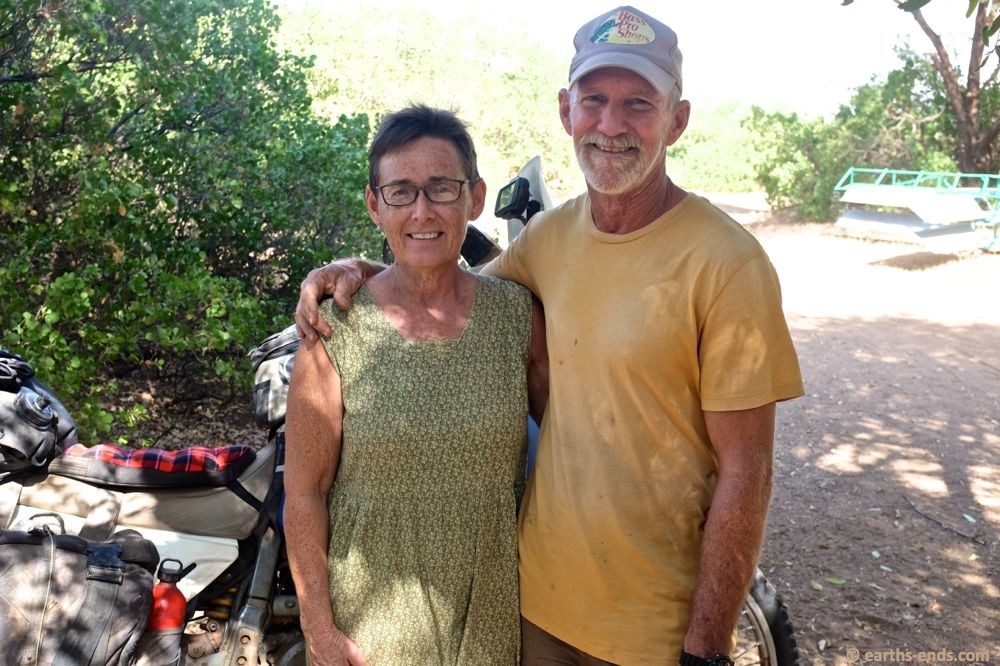
Our wonderful hosts
Ten days riding without proper rest in Ethiopia is a big deal and it shows just how keen we were to be in Omo with our fast friends. The warm welcome and incredible hospitality we received last time made our return feel like a home-coming which was hard to believe when you consider we only spent 3 days there the first time.
Once more it was peaceful days, wholesome home cooked meals and awesome late night chats with Dick and Donna. Not for the first time we were left thinking why on Earth didn’t we ditch Ethiopia and just spend 6 weeks here instead.

We were treated with the most amazing home cooked food. Here is Donna’s homemade ice-cream made from powdered milk, with peanuts and golden syrup. One of the best things I’ve ever tasted.
There was a tonne of washing to do but fortunately not all that much bike work for a change, just a broken indicator and a tube to patch from the nail Mick got south of Kibish Surma. We were thrilled to note Mick’s experiment with double tubing the tyres was a success, they were full of thorns from our ride through the acacia thickets. Unfortunately we forgot to take a photo of it. We started removing the thorns with tweezers and pliers but there were just so many we decided to cross our fingers we would make it to Kenya/Tanzania then chuck the thorny knackered tyres on the scrap heap. When doing this later we learned that a few thorns had pierced the tyre and were firmly lodged in the tube liner, confirmation of success of the experiment. In the absence of significant bike work we were free to become more familiar with the windmill project and see Dick in action carrying out maintenance of a few different mills.
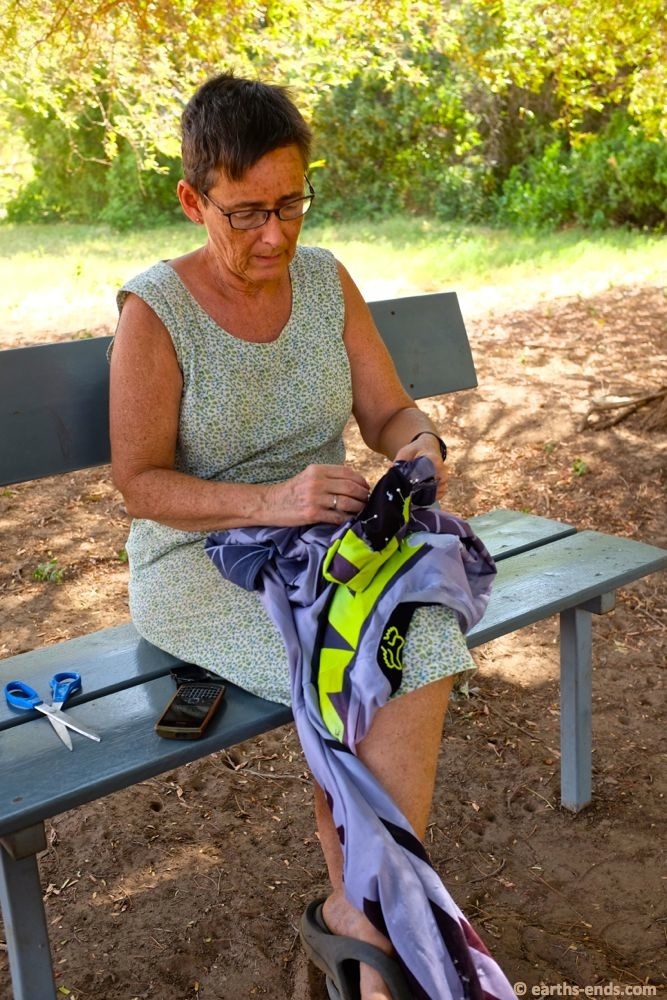
Donna lovingly repaired the damage to my jersey from my donkey crash back in Namibia.
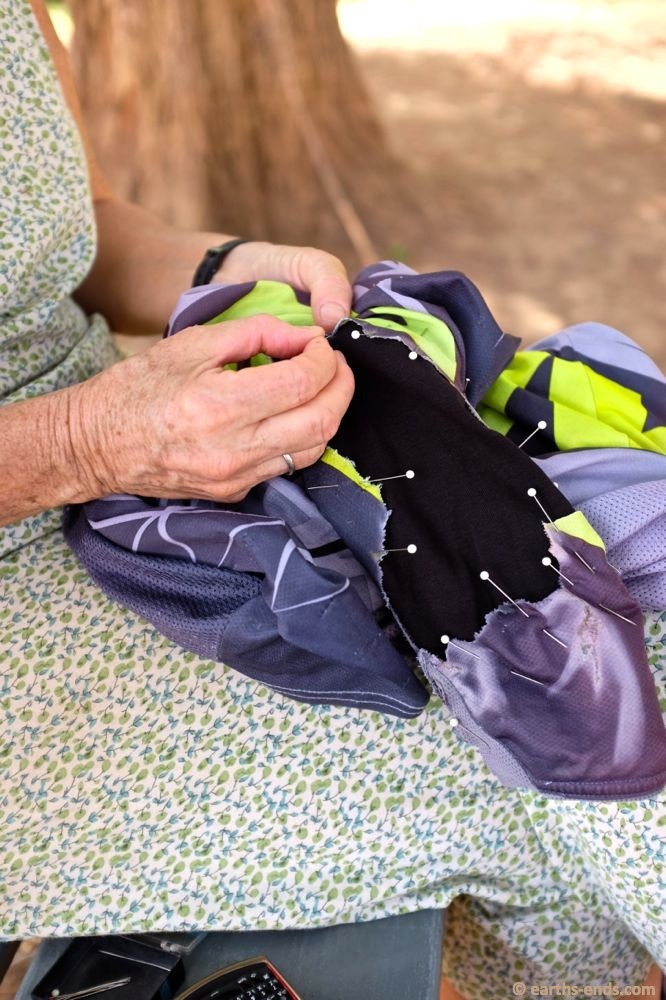
Making me a tiny bit more presentable. Honestly, how sweet is that!
Dick and Donna, simply put, are incredible people. Indeed that would have been the title of this blog and we would have talked exclusively about them if we weren’t sure they would be embarrassed by such praise and attention. So with that in mind we will aim to keep our adulation to a minimum for their sakes’.

The steep banks of the Omo River.
Water is life out here and the Omo is the life giver. The depth and relative fast flow of the Omo River gifts the tribes a reliable source of water generally free of water-borne diseases prevalent in other parts of Africa. But she really comes into her own during the annual flood where the river rises and spreads itself over the banks and across the parched, flat land as far as the highland rains allow. The roughly 200,000 indigenous people from the Omo valley to Lake Turkana rely on the natural flood cycles of the Omo for flood-recession farming and livestock grazing. For generations immemorial they have planted sorghum and maize along the river. It is this harvest along with the blood and milk of their animals that sustains the Daasenech. The larger the annual flood the more that can be planted and harvested, the shorter the hunger season. During the hunger season the Daasenech go into starvation mode, conserving their energy by exerting themselves as little as possible. During this time most people spend their days lying under a tree waiting until crops can be harvested and food becomes plentiful again.
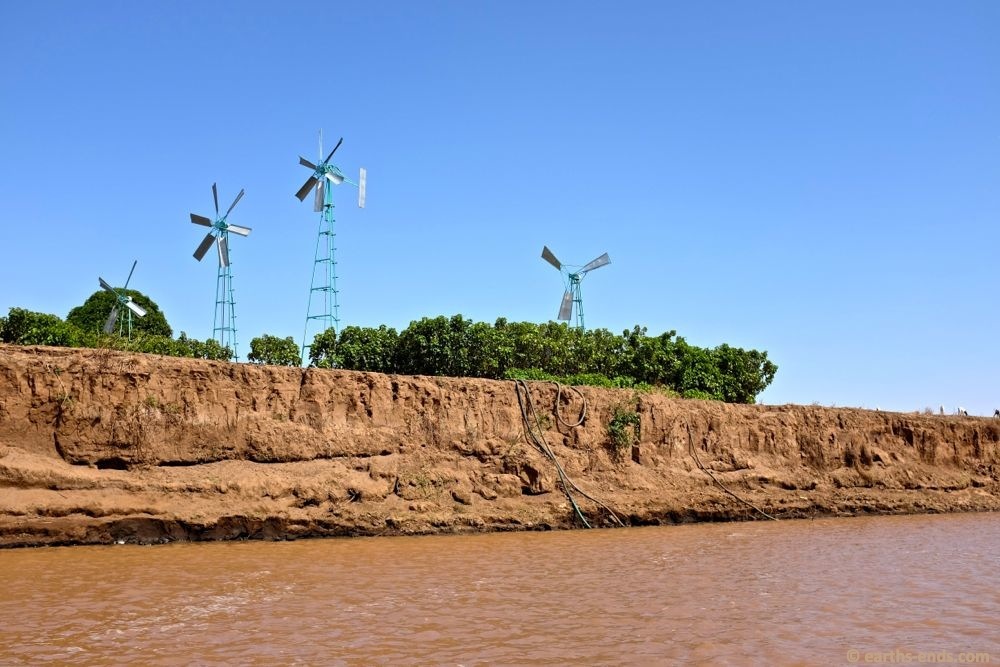
Dick and Donna’s windmills.
Now here is the thing that is hard to fathom as an outsider; it is exceedingly rare for people to sell their cows off during this time either to eat or buy grain to sustain them and their families. This is not to say that many people starve to death during this time. In fact, from what I gather from Dick and Donna, the Daasenech people are physiologically conditioned for this annual drastic restriction in food. Yet even with the annual floods the dietary requirement are not fully met and malnutrition is rife. And that is where the windmill project comes in. Dick and Caleb’s windmills pump water from the Omo year round to provide irrigation for planting crops to supplement diets and fill the void between seasonal harvests.
It feels inadequate to describe their windmill project as modest when you consider the transformational qualities to life it provides, however, in terms of funding and staffing it is certainly low key. No million dollar budgets, no overly lofty goals… theirs is an inexpensive project, running in the tens of thousands of dollars with pragmatic goals, low inputs, no self-congratulations, just hard work and huge dedication.

Off for a maintenance visit to the neighbours mill directly across the river.
During their decades at Omo, Dick’s parents, he and Donna, and his son Caleb and his wife have designed and constructed some 82 windmills along the banks of the Omo (excluding their own windmills). Most of the windmills are used for pumping water for small-scale agriculture, predominantly for growing banana and mango trees in addition to okra, peppers, beans and more. All of which can provide a much needed source of additional vitamins and minerals for the narrow diet of the Daasenech.
It is hard to explain what the project is up against in trying to encourage the up take of the windmills. The Daasenech people have been living a very particular way of life for many centuries with little variation through the ages. Even though they crop once a year, culturally they are pastoralists, not agriculturalists. Growing fruit and vegetables with the aid of windmills provided by some white man falls very much outside of their culture. But this missionary family have patience in spades.
Dick and Donna employ a guy to guard and tend the garden fruit trees that flourish in the barren landscape due to their windmills. Yet it took the guy 15 years before he decided to get himself a windmill. And even then it was mainly the sustained lobbying of his wife that this happen. He saw the ease of use and obvious benefit the windmills could provide every day but still took him 15 years to be convinced.
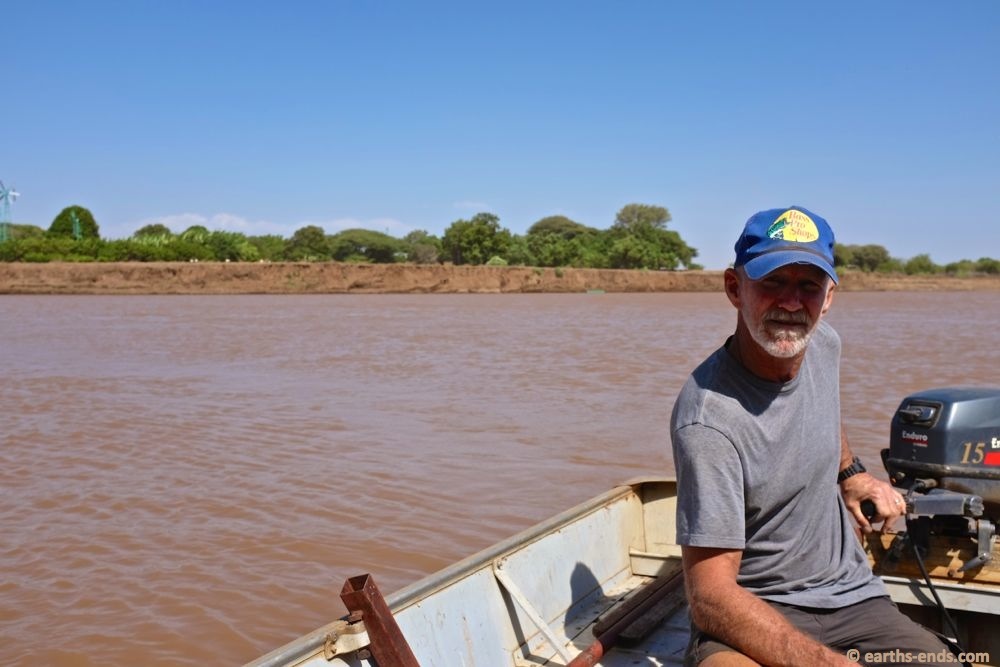
Dick – If you meet a guy that looks like this and claims to be Dick the builder of windmills but is NOT wearing a Bass Pro Shops hat Beware! He is clearly an imposter.
We joined Dick for a maintenance visit to the grinding mill of his neighbour across the river. The grinding mills save the women of the tribe hours of physical labour of grinding mealie by hand between two stones. And for those that own the grinding mills it represents a modest income stream in the same way as the tool sharpening mills do. Despite instructions as to the importance of properly drying the mealie first, this mill had gotten clogged with moist grain. ‘Diggi’ as Dick is known among the Daasenech, was requested to rectify the issue.

Over many years Dick and Caleb have experimented and refined their windmill designs and now have windmills used for irrigation, knife/tool sharpening and grain grinding. They also have a small wind powered electricity generator in their compound.

What happens when you mill moist mealie. Clogs, then stops.
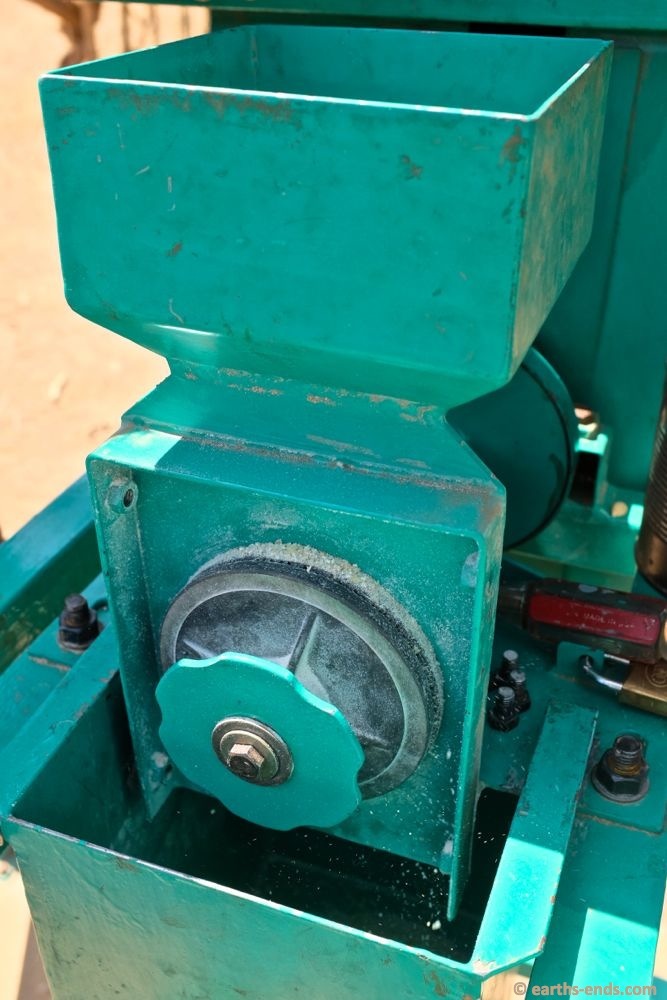
Working again but not optimally – to Dick that simply will not do!
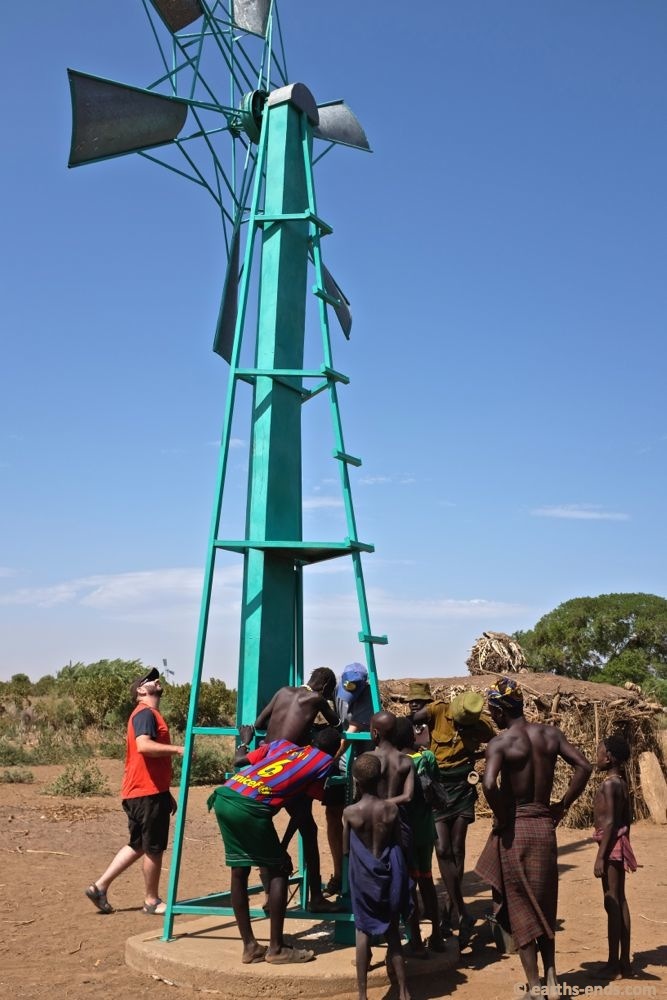
Everyone was interested to see what was going on.
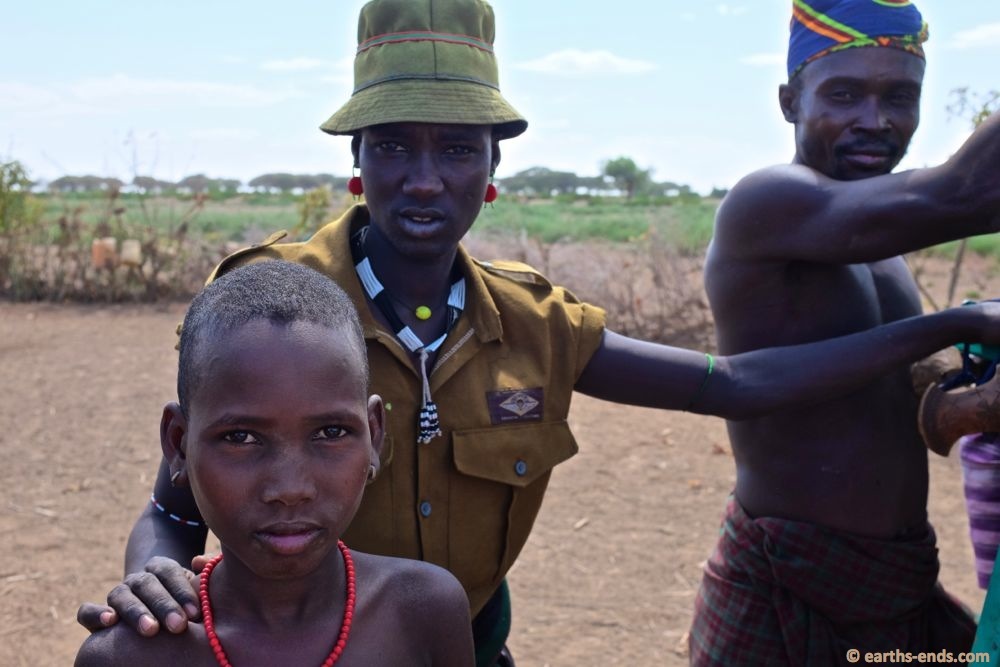
Including these guys.

The mill owner’s pizza oven. No no, it is their home that merely acts like a pizza oven, which is unfortunate because traditionally the Daasenech would make their dwellings to the same design but with vegetation and animal hides, which is far cooler and appropriate for this environment. However some time ago it appears an aid project came and gave out sheets of corrugated iron. The Daasenech got something for nothing and some NGO or government agency got to say they had provided housing to thousands of people in the Omo Valley – “please give us more money to do it for thousands more – a few million dollars should do it.”
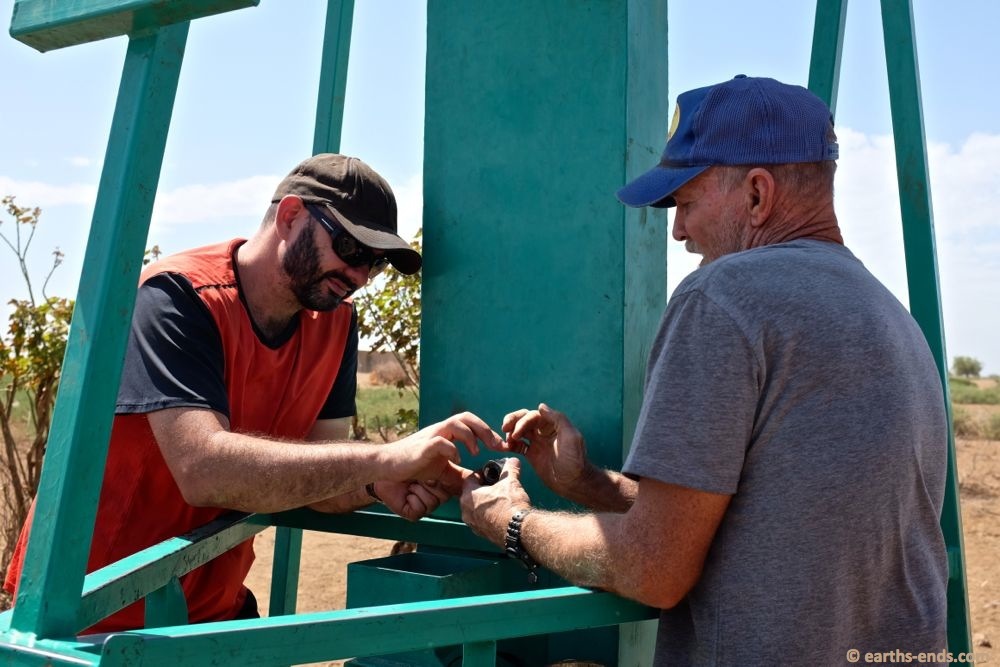
Mick and Dick in problem-solving mode. After unclogging the mill Mick and Dick noticed that it wasn’t the only issue at play. The augers Dick had sourced from the US were designed for grinding small and more uniform grain, like wheat. For the next couple of days Dick fabricated some hand-made augers, experimented, tested and refined them to better suit picking up the irregularly sized and shaped dried maize.
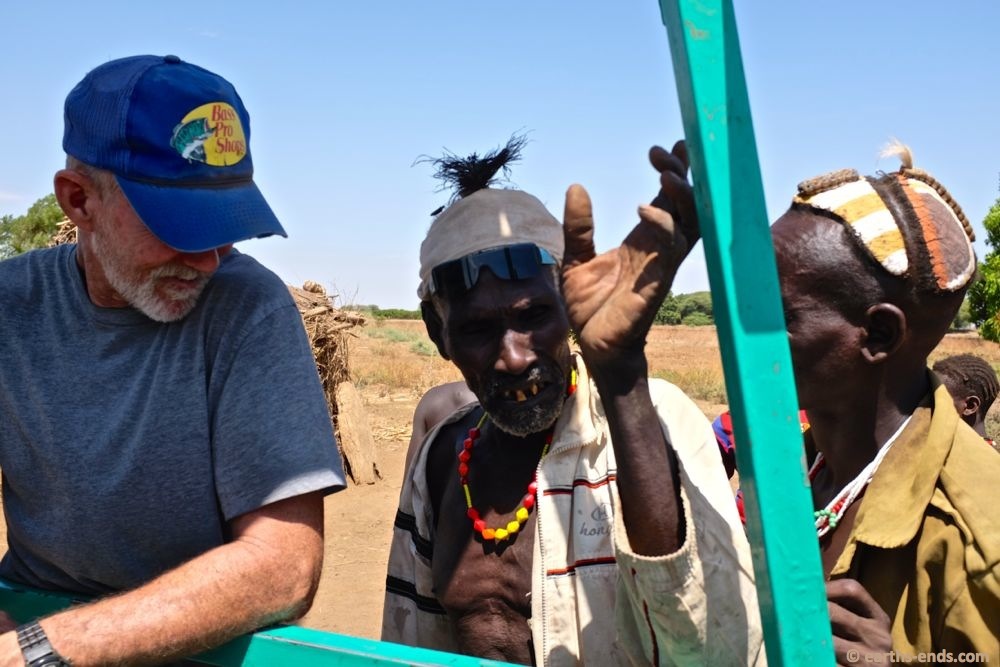
Dick chatting with the owner of the mill (the old fellow in the middle). But take note of the hairstyle on the guy to the right. This is a traditional Daasenech clay hairstyle that takes a lot of time and effort. Step one to getting a bangin’ Daasenech doo involves a 60km round trip walk into a war zone. The specific clay required just so happens to be across the border in South Sudan. With that sourced, a stylist will apply the clay to the hair creating a sort of cap separated into a number of sections. The clay cap is then textured and painted. A bird or ostrich feather serves as the cherry on top of the sundae.

Here is another example of the clay hairstyle. All the care and attention to the hair needs to be repeated about every six weeks weeks, depending on rate of re-growth and how careful one sleeps; lots of sleep-time twisting and turning damages the doo. Now that is commitment to a look! The Daasenech use a carved wooden stool that doubles as a pillow. The hairstyles are designed around the stool in order to help and preserve them during sleep. They might look impressive but these hairstyles must be uncomfortable. Many men carry a thin, curved stick for scratching beneath the cap as the hair grows. From time to time Dick is visited by men asking for some kerosene to pour under their mud caps to kill the headline beneath that they can’t scratch.
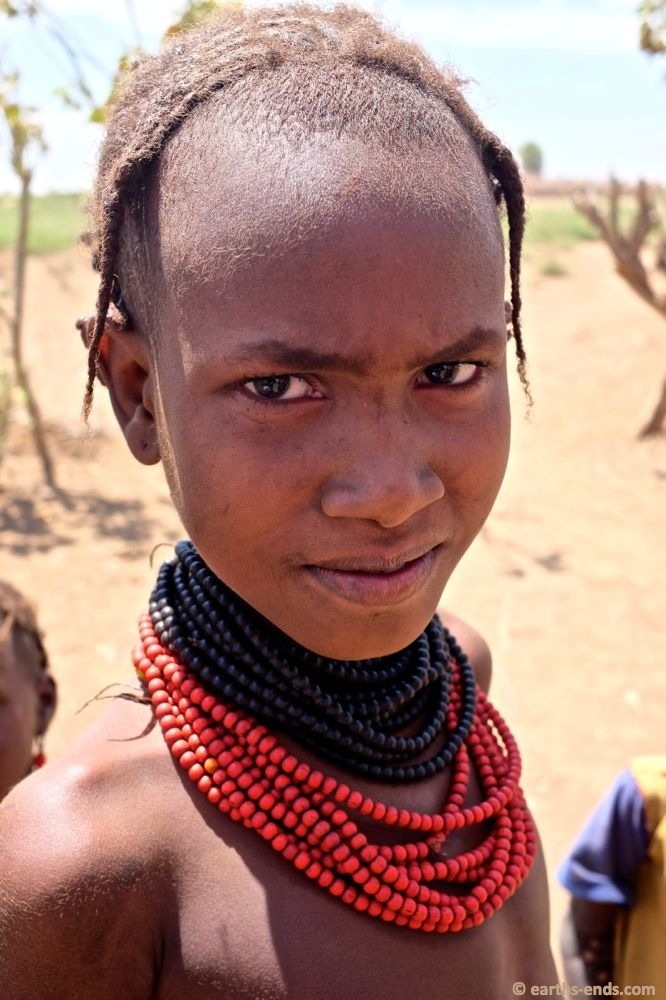
Here you can see how the girls style their hair.

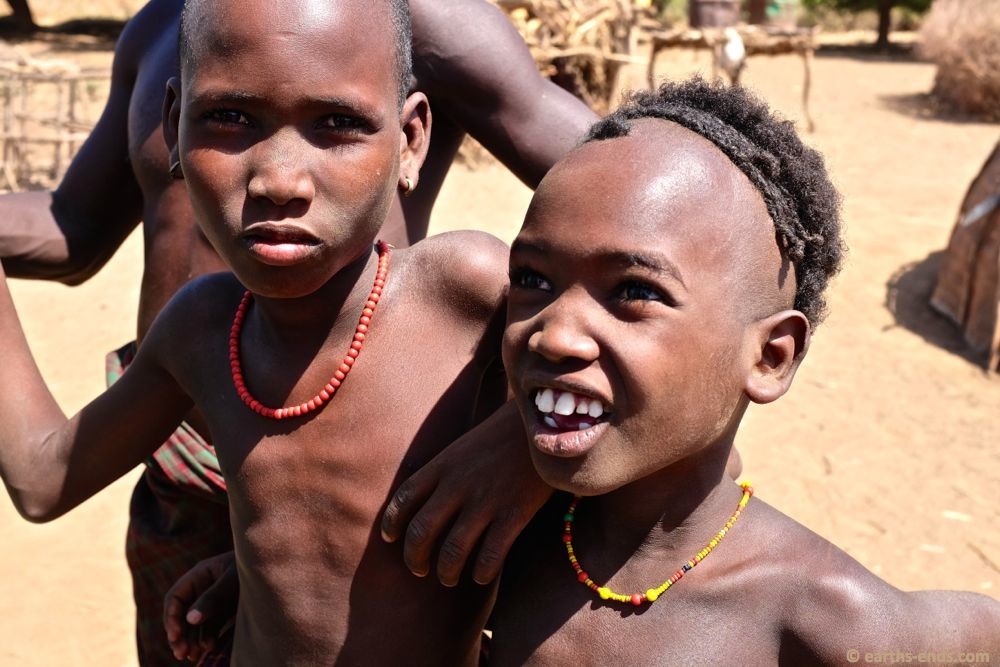

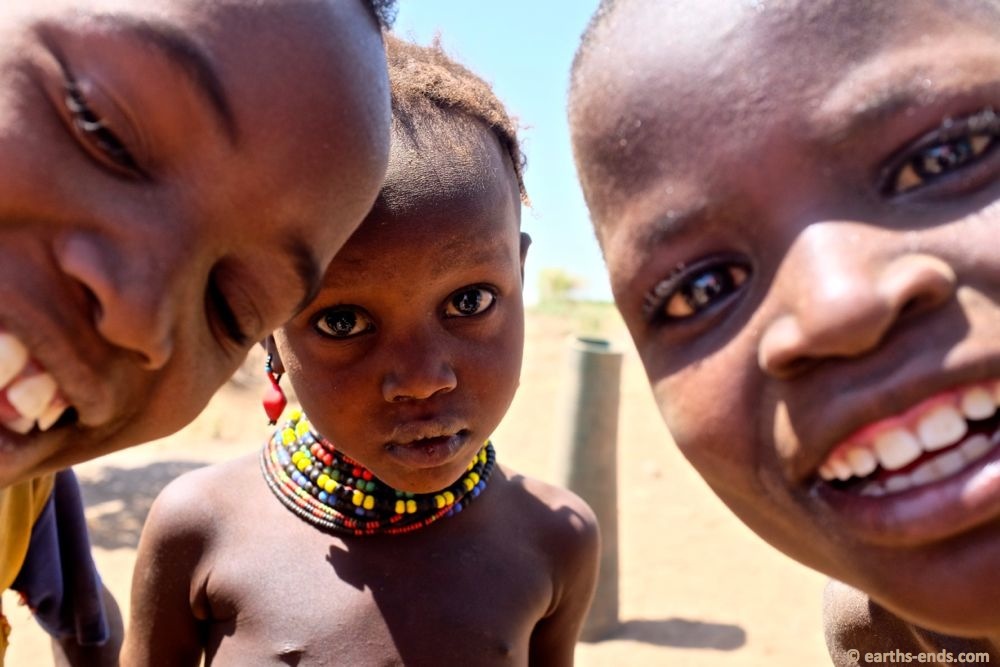

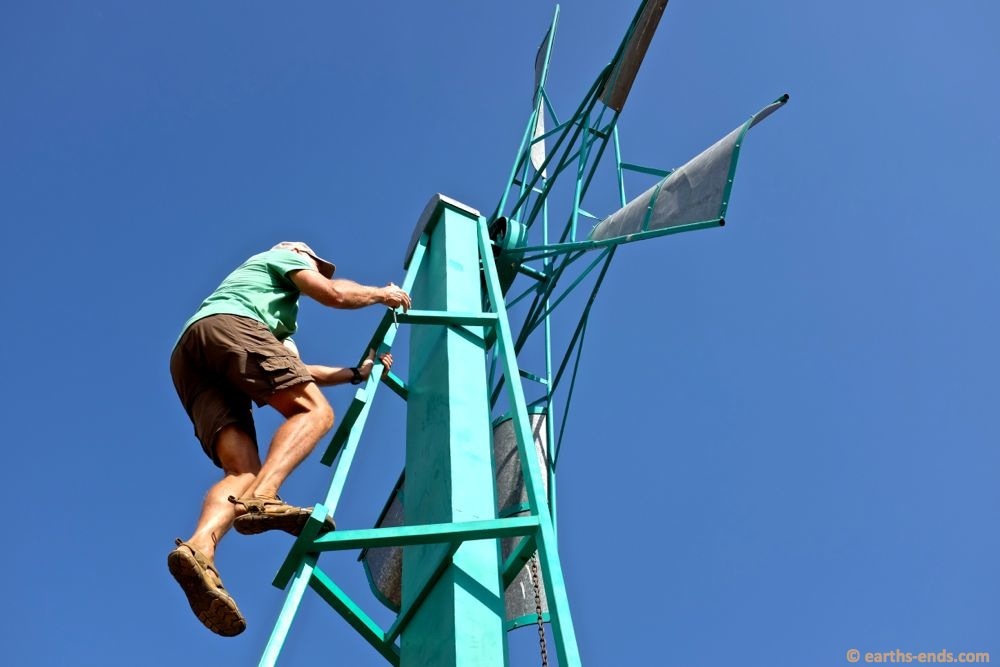
We visited another windmill in need of repairs. The drive belt had snapped after the fish plate that joins the belt came loose and starting rubbing on the housing, and the owners just ran the mill with the “whack whack whack” noise until the fish plate finally caught and the belt snapped. It was a point of frustration for Dick; the owners of the mills are technology and mechanically illiterate, they just use stuff until it breaks. It turns small quick jobs into an endless stream of big complicated jobs for him and his two maintenance men, Erogit and Guradit. Maintaining 82 homemade windmills is a huge job and while he has been trying to encourage the windmill owners to be proactive and report issues before they become big problems, he is still a way off from achieving this.
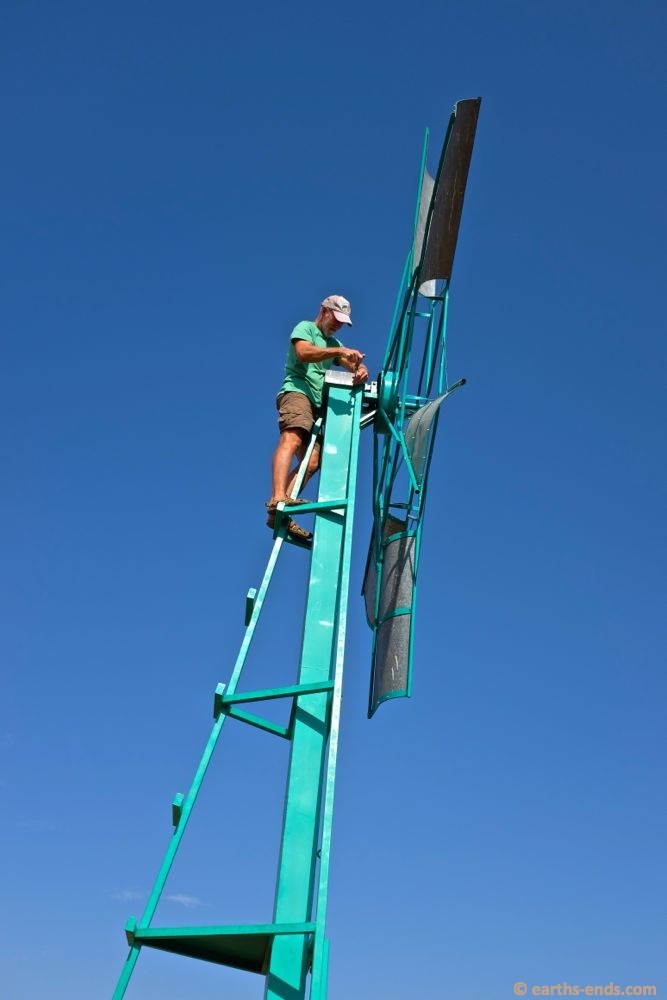
We appreciated the sense of pride Dick has in his windmills that sees him immaculately painting every surface the same Tiffany blue colour. He has a high standard for his work and does not subscribe to the ‘good enough for Africa’ mentality.
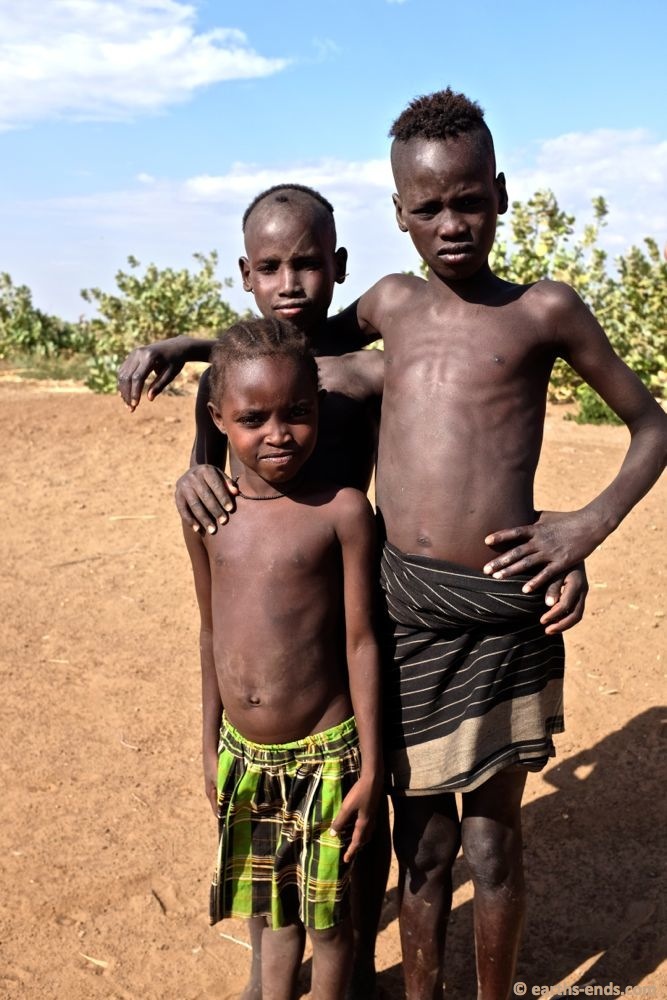
We had an audience
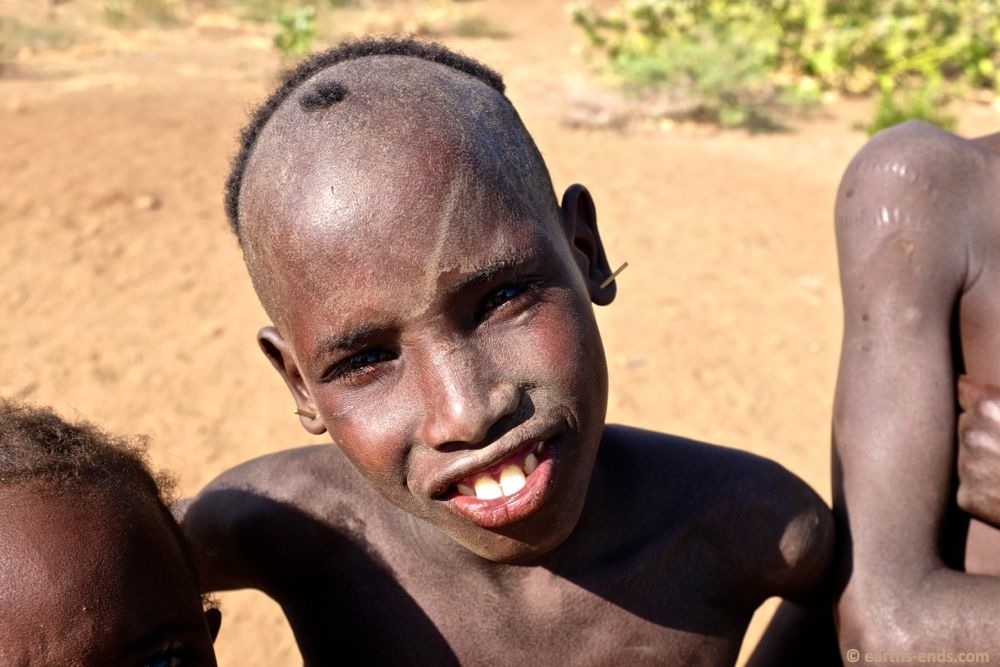

They kept me entertained while the fellas saw to the windmill
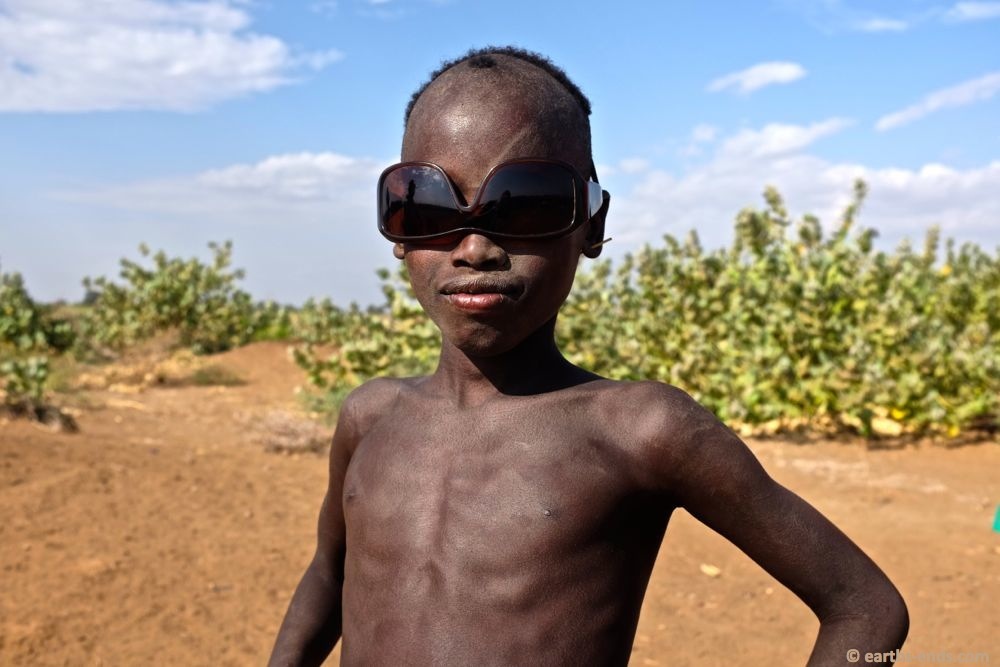
His confidence made me question if I wasn’t the one wear my sunglasses the wrong way.
While we were at Omo we had the opportunity to join Dick and Donna for church on Sunday. It was a distinctly Omo affair that we are glad to have experienced. Church takes place under one of the rare bits of shade in the area; the dome. The dome was formerly a shelter structure of the mission station when it was first set up by Dick’s parents. It was a small turnout as many of the local Daasenech had already packed up their belongings and moved (mostly south to the delta) in order to find land for grazing their animals and planting their crops in lieu of the annual flood. Those that remained were perhaps holding on in anticipation of a flood that won’t come. Or perhaps they were just too busy wondering how the future suddenly got so uncertain and were simply unsure of what to do next.
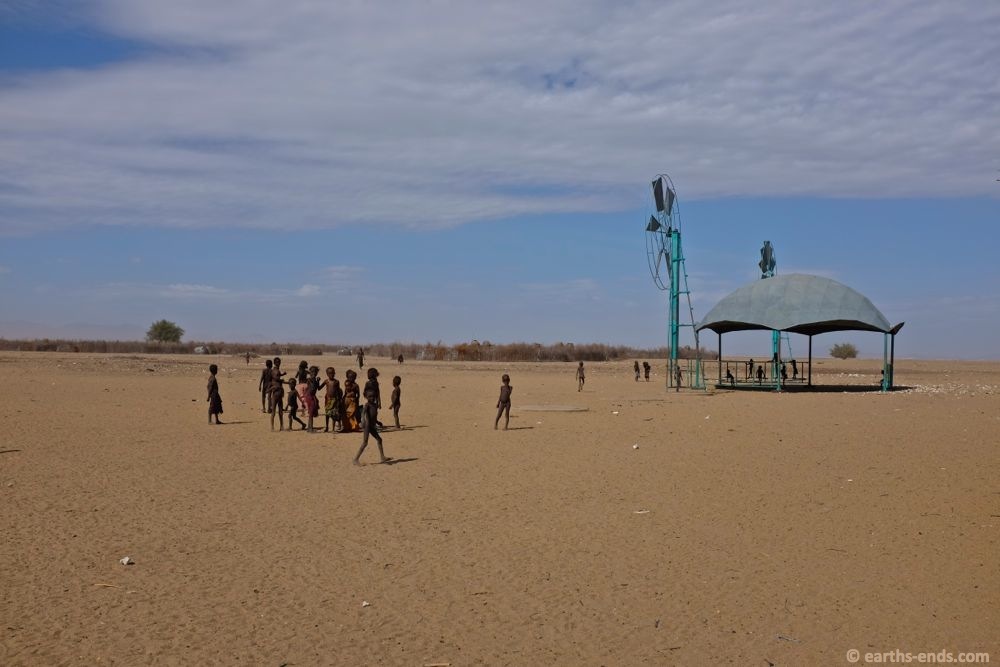 On the way to church.
On the way to church.
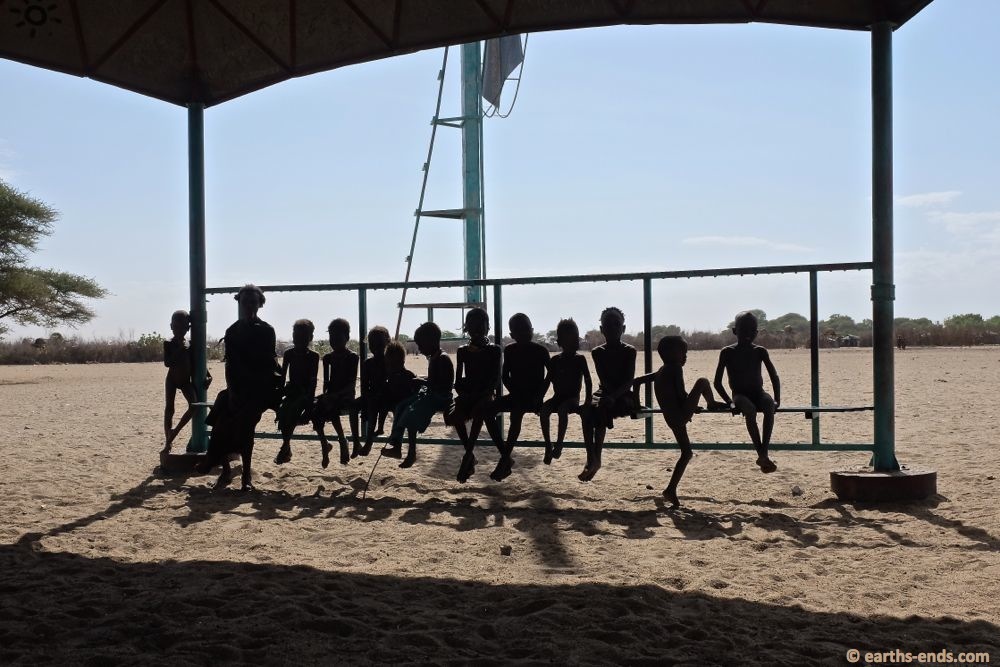 Waiting to the Sunday service to begin. Its a clothing optional church.
Waiting to the Sunday service to begin. Its a clothing optional church.
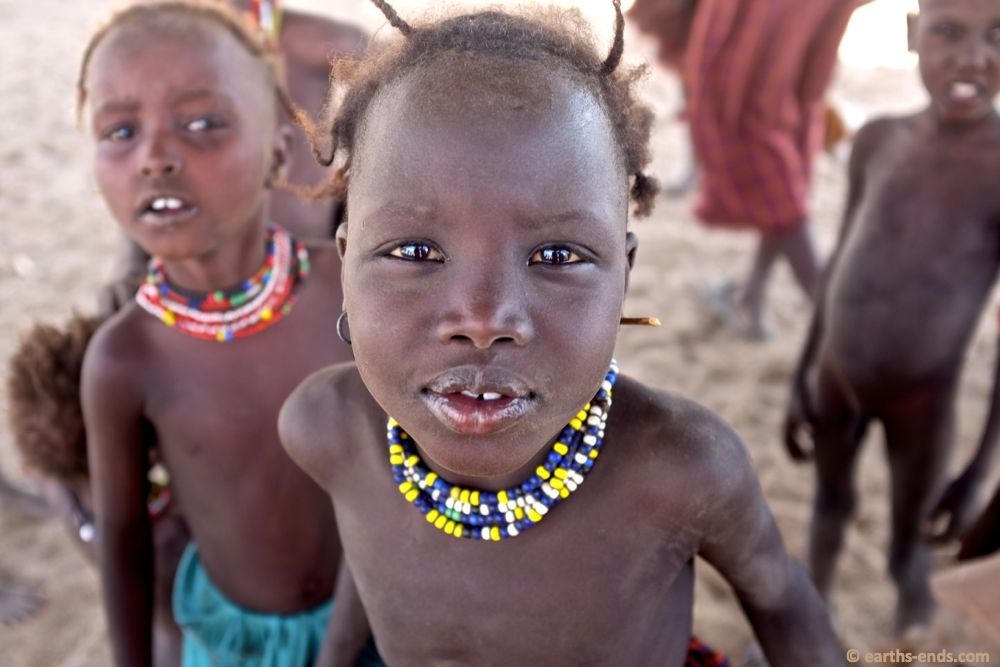
The kiddies came for the singing and clapping….but stayed to stare at us newbies.
The Daasenech minister was out of town so his wife Marta was standing in his stead. The entire service was in Daasenech so we couldn’t understand a word. She was clearly nervous reading in front of everyone but we were so impressed by her passion and determination as we knew that Donna had been teaching her and her sister Aster to read. Their efforts to learn to read are all the more impressive when you consider that it was only the year previous that saw the first book ever published in the Daasenech language, the good book. It took a husband and wife missionary couple some 30 years for the written language to be devised and the bible translated.
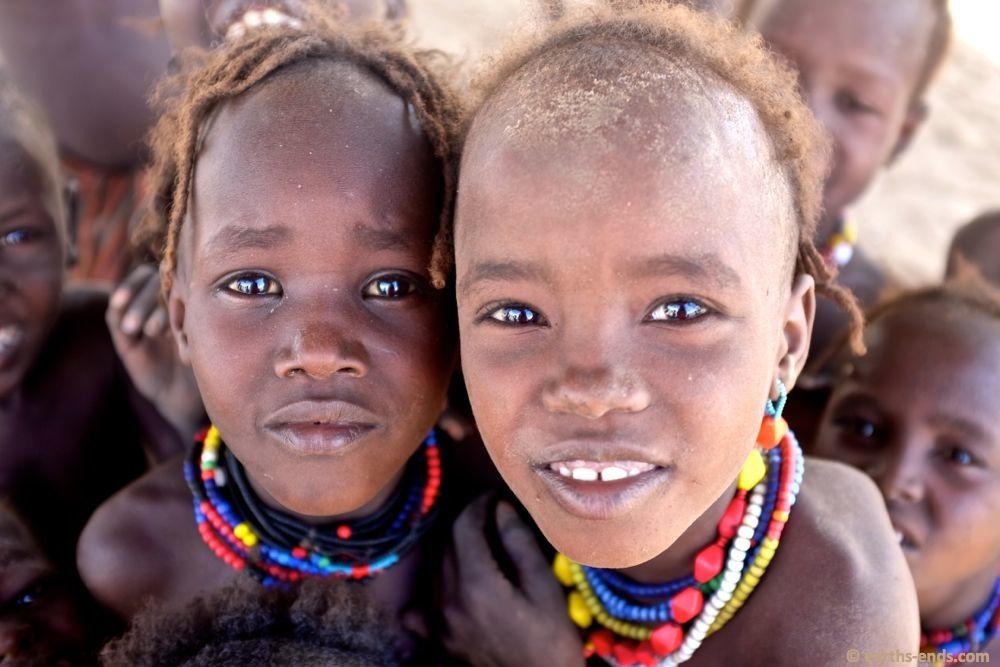
In between readings and prayers there were songs and clapping and we were once again struck by the incredible sense of rhythm Africans, the continent over seem to have. Meanwhile Mick and I can barely clap in time and can’t hold a tune in a bucket with a lid on it.
The highlight of the service for me was watching one of the seriously devout older ladies stand up and give a memorised bible reading. For the older ladies like her, Donna has offered rote learning classes for passages from the bible. As she stood there, eyes closed delivering a long address, I couldn’t help but be touched. Whatever it was she was saying seemed to mean a great deal to her. I wasn’t surprised to learn that is was predominantly women who were the most loyal church attendees. The life of women in these parts is particularly difficult. It was nice to see that religion was providing them some solace.
After the service that woman asked Donna to check in on another of the older ladies who was very unwell. Donna is a nurse and in the past had offered much needed heath services before bureaucracy ended all that. Donna examined the old lady while we waited outside the hut, and when she returned gave the grim news she was very unwell and appeared to be suffering from both TB and malaria. But she had converted to Christianity, which can be a life-saving choice in these parts. And while that may seem to some a zealous over-statement, it really is not. Here is why.
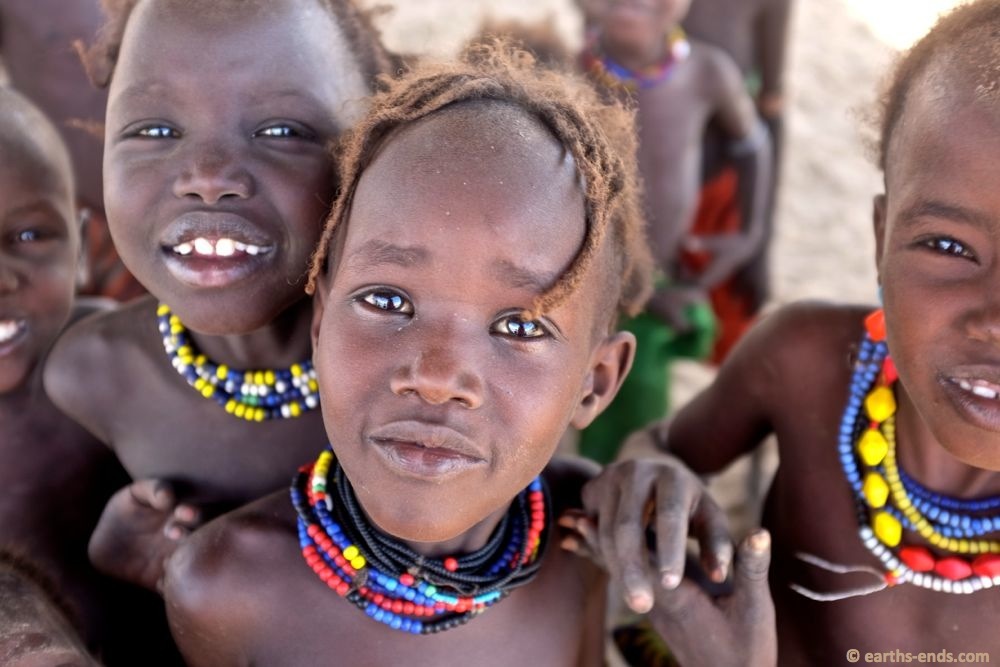
Some very cute kids
The Daasenech are in many ways held back and even dying for some of their age-old traditions. Daasenech are animists and traditionally believe that when a person or animal is sick they should be denied all water until they are better, for drinking water only sustains the evil spirit that is making one sick. That is tough going in a place of such high temperatures and leads people to die of dehydration before the disease afflicting them.
This is just one aspect of what is probably the greatest impediment to heath improvements in the area; the traditional belief that maladies occur purely due to bad spirits, curses and the evil eye. These beliefs made Donna’s health outreach work all the more challenging; how do you convince people not to drink stagnant water near the local err… toilet facilities when the only believed conduit for illness is from a curse? What can washing hands do in the face of a curse?

Donna told us of the ‘curse racket’ that perpetuates these beliefs. When someone becomes sick a frequent course of action is to seek out a witch doctor to find out who placed the curse. The witch doctor gets paid to finger someone as having placed the curse. Satisfaction is guaranteed as any accused person will almost certainly go on to admit having done so even if they haven’t as there is a pay-off. “Ahhh… sure… yeah I put a curse on him… give me a goat and I’ll umm… take the curse away.”
Look, I am of the belief that people have the right to believe what they want to believe. But there are devastating consequences of the belief in and fear of curses. It makes people afraid to prosper as jealousy begets curses and curses cost money and goods to lift. Many people decide it is safer and easier not to stand out, not to expose themselves to harm when their efforts might not be worthwhile in the end. We have heard of this problem a few times through Africa, it isn’t an Omo problem; it’s a superstitious fear problem.
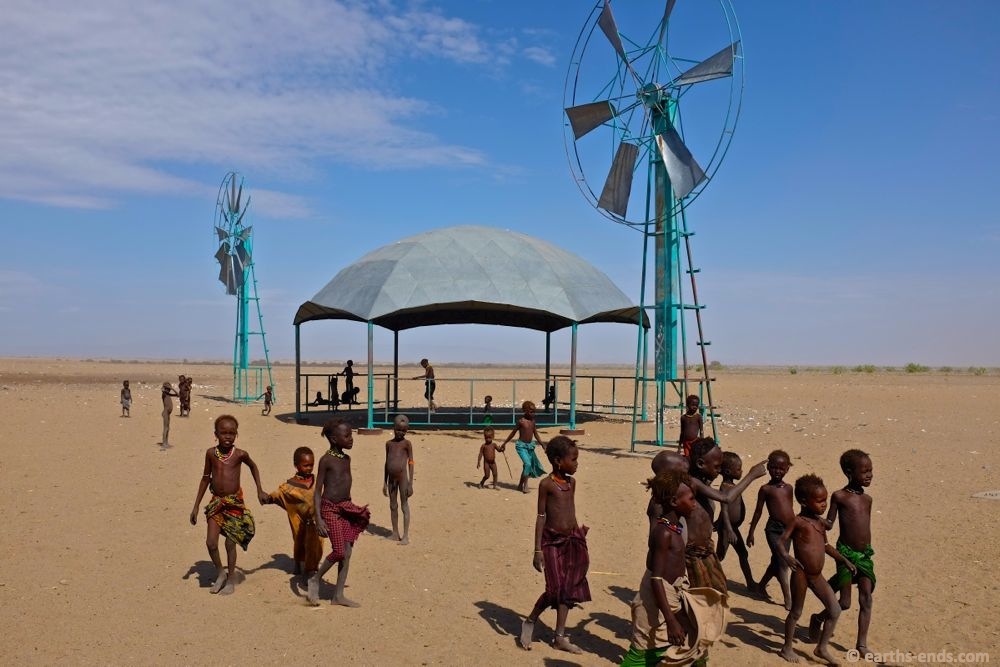
One of my favourite pics from Omo. It is Mad Max looking country out here.
And in the specific case of the Daasenech fear of evil spirits leads unwell people to be shunned by their family members out of fear, especially when it appears the end in near. Often the sick are left to die alone under a tree or in a hut so the bad spirit that is killing them can’t then go on to effect anyone else. It’s a tragic scene that Donna and Joanna have come across multiple times over the years. It is all really heavy thought provoking stuff; dying alone of dehydration because of an easily preventable illness combined with an unfortunate belief.
In the developed world our appetite for preserving the traditional customs of others is almost as fierce as our appetite for change and modernisation in ourselves. A less palatable way to put it might be that we westerners want loincloths for Africans for our photos and iPhones for us to take them. And before coming to Africa and witnessing the whole continent on the cusp of change, I too had this first world-er default position of ‘preserve’ these wonderful tribes and traditional beliefs and ‘shield’ them from the encroaching modern world. But what if these traditions are killing them and what if the modern world can’t be stopped?
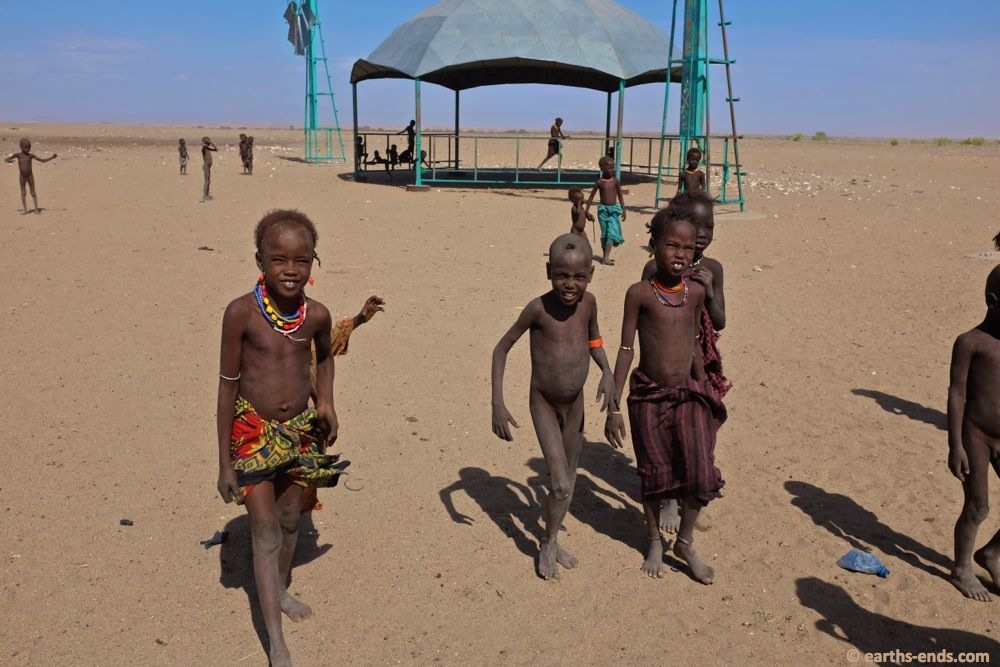
Lots of kiddies get around in the nude here. Donna tells us it can be confronting to outsiders who visit. People plead with them to provide clothing to these poor children. As far a Donna is concerned the kids are well served going starkers as it is cultural the norm, comfortable in the hot conditions and it saves the kids a lot of skin conditions such as scabies which is very common is places like this where washing clothing adequately is not so easy/the cultural norm.
It was challenging to find ourselves questioning that ‘first world-er default position’. It feels right, just, open-minded and admirable to think such things. It feels respectful… but it isn’t necessarily. In fact it might well be the opposite. It isn’t necessarily respectful to fight to preserve traditions in a group that you haven’t taken the time to understand. It isn’t necessarily respectful to fight to preserve traditions that these people themselves might not care for but can’t conceive of another way. Donna has on multiple occasions tended to babies with broken jaws from the failed attempts to knock out teeth that have grown due to what their culture defines as the incorrect sequence. Donna asks time and time again why they do it, “because its what we have always done” is the inevitable reply. There were times in certain tribes a baby could be deemed unlucky before birth and a threat to the tribe; a death sentence to be carried out upon their birth. Traditions can be quaint and benign, or pervasive and malignant. One should at least take the time to know the difference.
While we were waiting for Donna we came across a murderer. A young man of about 20 years was adorned with dozens of necklaces collected as a form of tribute by women from the tribe. They were loaned to the man to celebrate him having killed a member of an enemy tribe. Perhaps he killed a grown man in armed combat or perhaps he snuck up in the night and emptied some round from an AK47 into the hut of a sleeping family (this has been known to happen). We didn’t care for details ourselves. Either way by local custom, the killing of any member of an outside group was cause for celebration. He offered to pose for a photo for us for 200birr, about US$10. We weren’t interested in further rewarding him so declined.

These windmills were formally communal grinding mills. The grinding mills saved the women a huge amount of time when it would take between 3-4 hours to grind enough maize for a family meal by grinding stone. However, in a type of tragedy of commons situation, the shared resource of the mills meant they weren’t cared for well , constantly falling into disrepair when there was no sense of ownership. That is how the goat fee for the mills came along.
From what we understand, for a kill to be celebrated there has to be some kind of proof of the killing, be it a witness or collected possession of the deceased. With that established it can be a rather drawn out celebration. The necklace gathering occurs in the early stages of proceedings. When the killer in question is sufficiently drowning in necklaces he takes to swanning about like king cock (as per our young follow). This may go on for some months before the elders decide it is time to move to the next step of doing the ritual scarification, which involves more celebration and the killing and eating of goats. We learned that in recent times elders have been getting greedy with these and other traditional celebrations, drawing them out and compelling goat donation after goat donation, sending fellow tribes people into a further impoverished situation. A cynical person might see this as proof of the corrupting nature of power, a cynical weary person might simply change the subject.
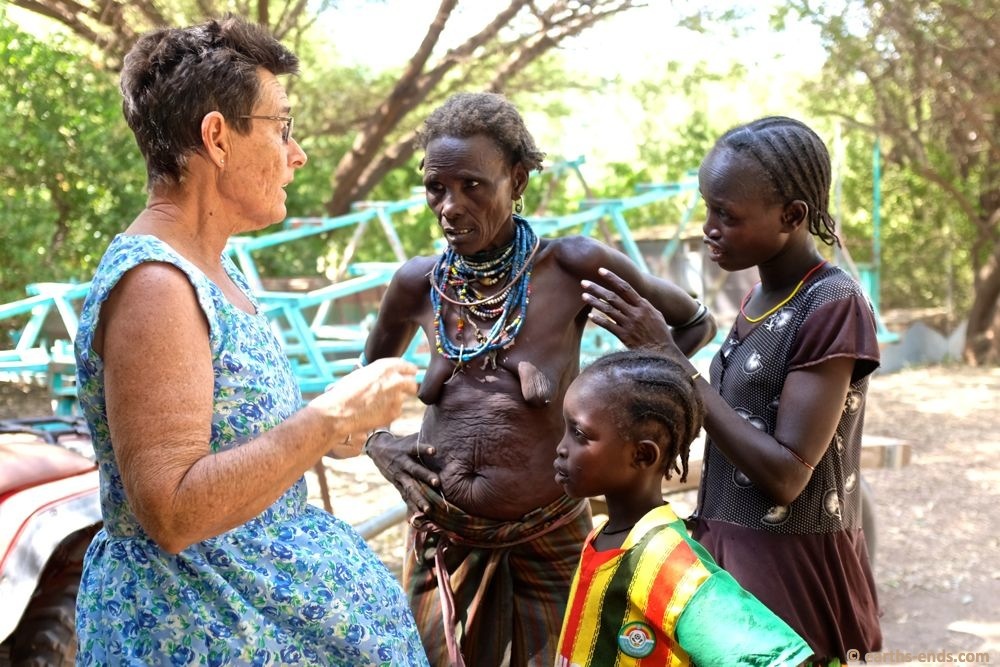
The lady in question, seriously listening to Donna’s instructions for the medicine.
Once Donna had finished her assessment of the sick old lady we headed back to the house to collect some medication for her. The old woman who had bought the sick lady’s plight to Donna’s attention came along and listened intently to the instructions for the medicine. We were to learn that this wasn’t the first time this woman has looked out for the well being of others. She has previously taken in and cared for sick people with no one else to turn to. This is an exceedingly unusual thing to do given the deep fear of curses of the Daasenech. I thought about what it would take for me to do something as brave and revolutionary as that old woman.
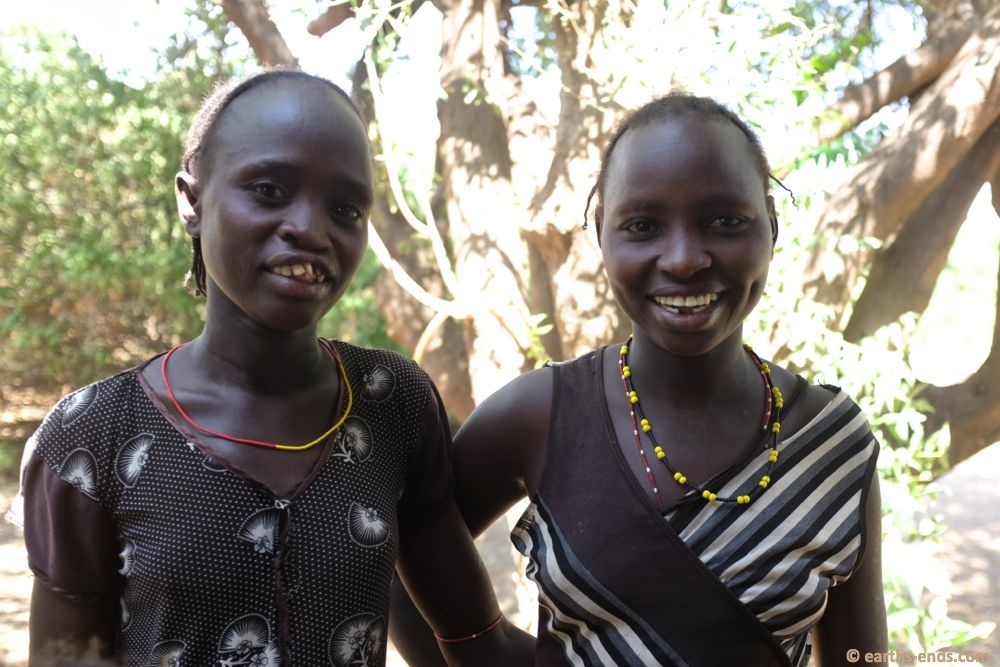
Proud Aster and her sister Marta who can now read the Daasenech language. I asked Donna to tell Marta I thought she did a great job reading during the service. Marta was over the moon with the compliment. Marta and her husband the minister were married some time ago in a Christian ceremony attended by Dick and Donna and their family. Their vows were very Daasenech as she vowed to love him even if he lost his cows and he to love her even when she can’t have more children.
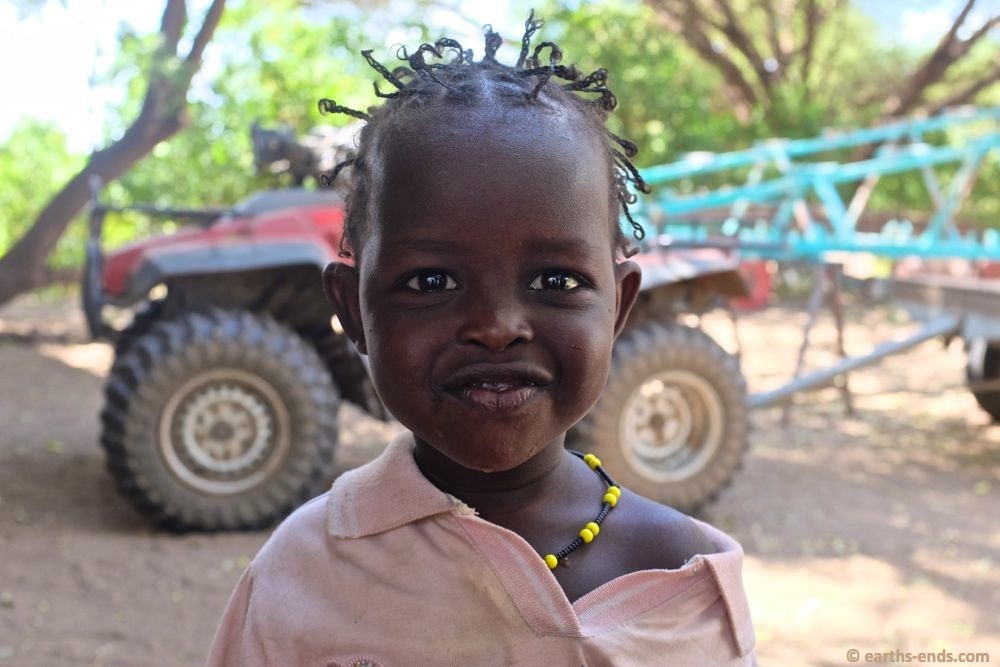
Marta’s daughter and A1 cutie.
She would have been told her entire life that to care for a sick person was exposing herself to deathly risks. No one around her would have ever done what she has done. Likely she was advised against it. Everything she ever would have been told about surviving would have been to avoid at all costs leaving herself open to bad spirits such as those residing in ailing bodies. It blew my mind to think what it must have been like to ignore all that cultural pressure and take in someone dying who wasn’t even a family member. It’d be like convincing yourself that you’d be okay jumping off the 50th floor of a building… and jumping. And while that analogy might sound silly, many believe in curses as ardently as we believe in gravity.
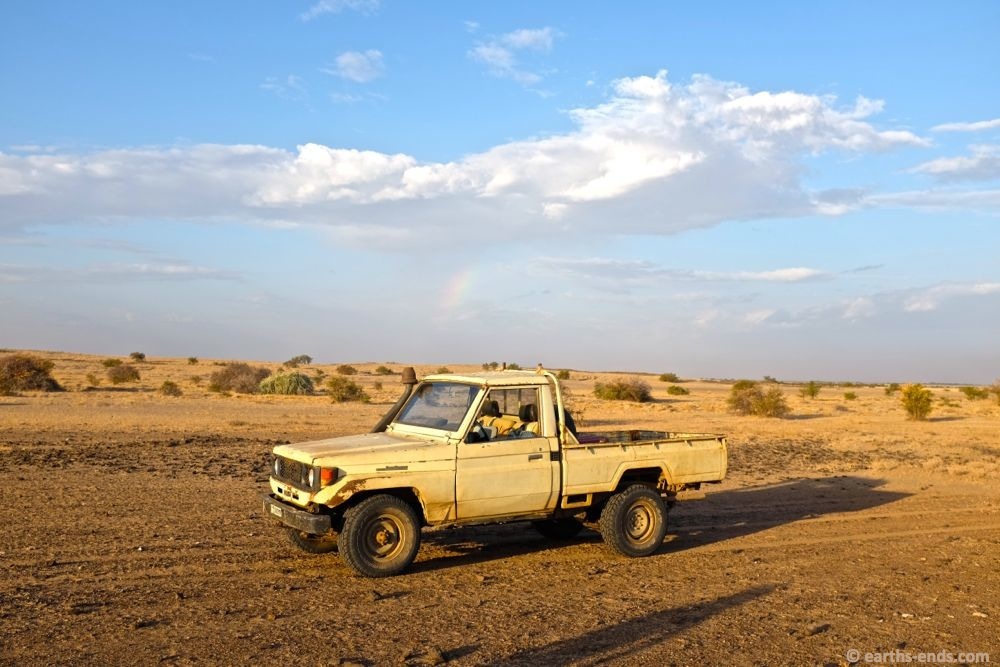
Our chariot for the cook out excursion.
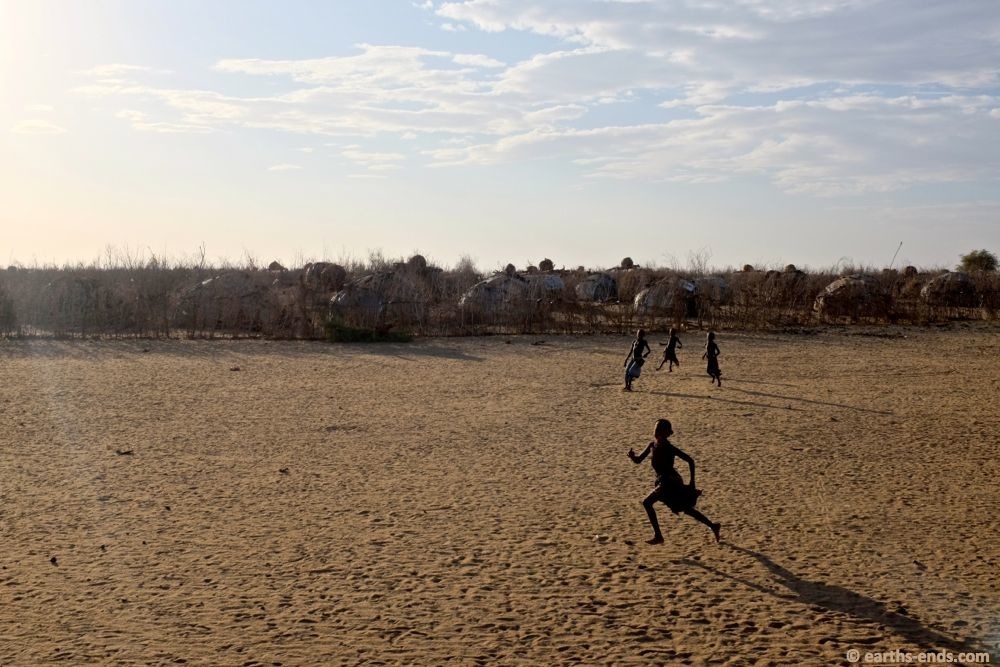
The village.
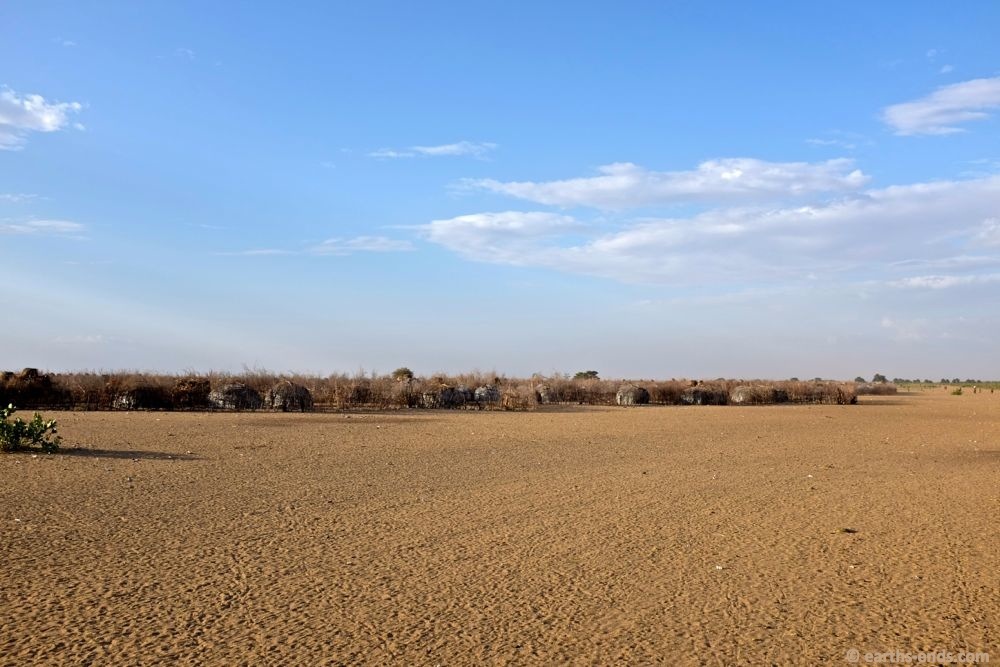
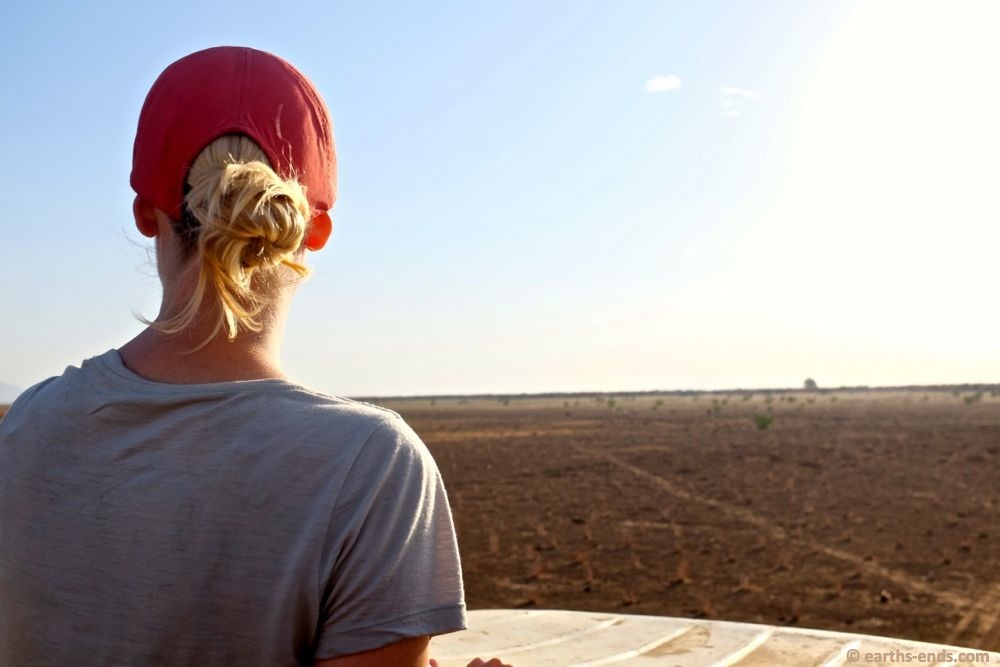
Views from the tray of the Landy.
One of our stand-out experiences from Omo was being taken on to the ridge for an American style cook out. We jumped in the back of the old Landcruiser and drove along the flat plains due west. Along the way we came across the relicts of big money and wishful thinking… there are a lot of these around this part of Ethiopia. Despite the furnace like conditions and the poor excuse for soil someone had the bright idea to invest millions in a cotton farm here.
An Indian company resolved to pump water from the Omo and irrigate vast fields of cotton. The physically intensive work of weeding and cotton picking would naturally fall to all these poor people who would no doubt be super stoked to be earning money to buy food and nice things. However the poor Daasenech weren’t interested in busting their hump for a dollar a day when they could be lying under a tree watching their goats for nothing. That, after all, is the epitome of contentment for a Daasenech.
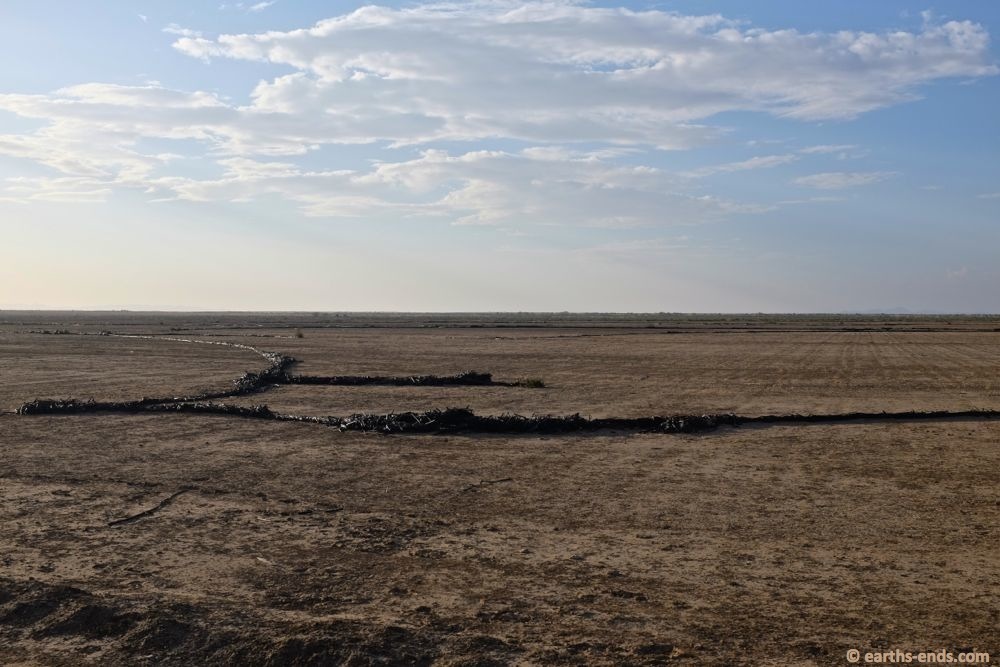
Derelict hoses and pipes as far as the eye could see. It made me think of how Caleb had joked with us that the Omo Valley was like Tsavo in the movie ‘The Ghost and the Darkness’. In the movie there is a line that says “Everything fails in Tsavo.” He says that is what it is like in Omo – “Everything fails in Omo”. His tongue in cheek comment felt all too real upon seeing this.
The cotton farm struggled from the outset. The foreign owners soon learned that their labour force, in spite of their extreme poverty, valued some things more highly than money. The real fly in the ointment however, was the environment. It was just too hot and the soil too inadequate. Having the water pumped from the Omo is one thing but it is the disposition of nutrient rich sediment in the annual flooding that allows the crops to grow here. It is for this reason the cotton plants only grew to knee height. Within 3 years the project went kaput. The Indians left and what lies left behind is now owned by some bank. We couldn’t fathom how they could have thought the project would work here. The only thing more ridiculously placed would be a sugar cane or palm oil plantation. Naturally, sugar cane and palm oil plantations are ear-marked for the region too. Perhaps no-one has told them, “everything fails in Omo”.
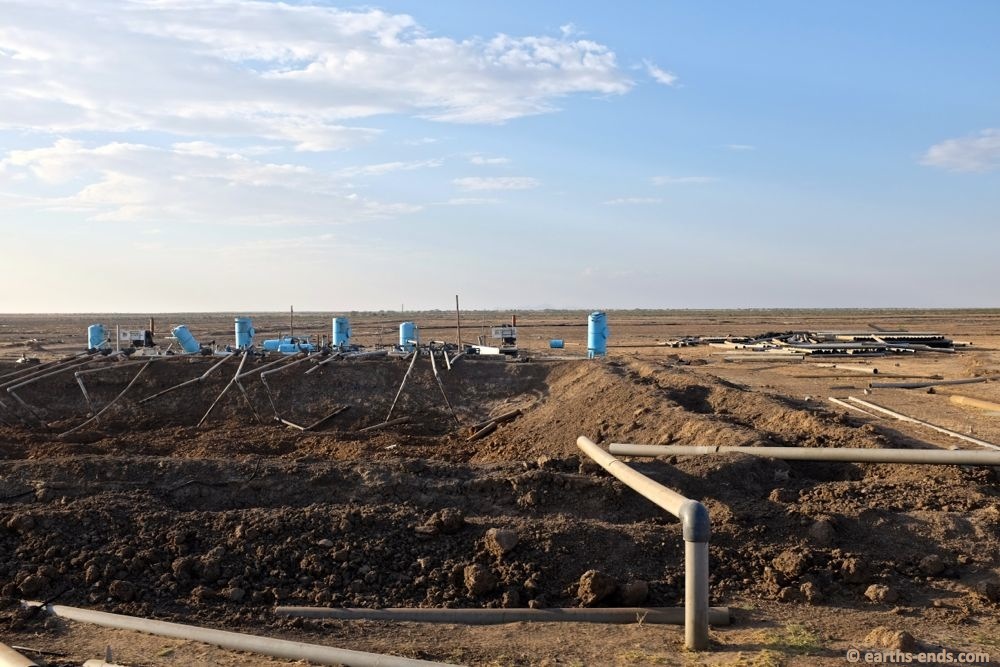
The Omo Valley is full of failed projects like this, be them commercial or charitable. Aid in Ethiopia is often a case of more money than sense. All over the place you’ll find the sun damaged remains of failed endeavours…..often right next to the sun damaged remains of the last failed endeavour.
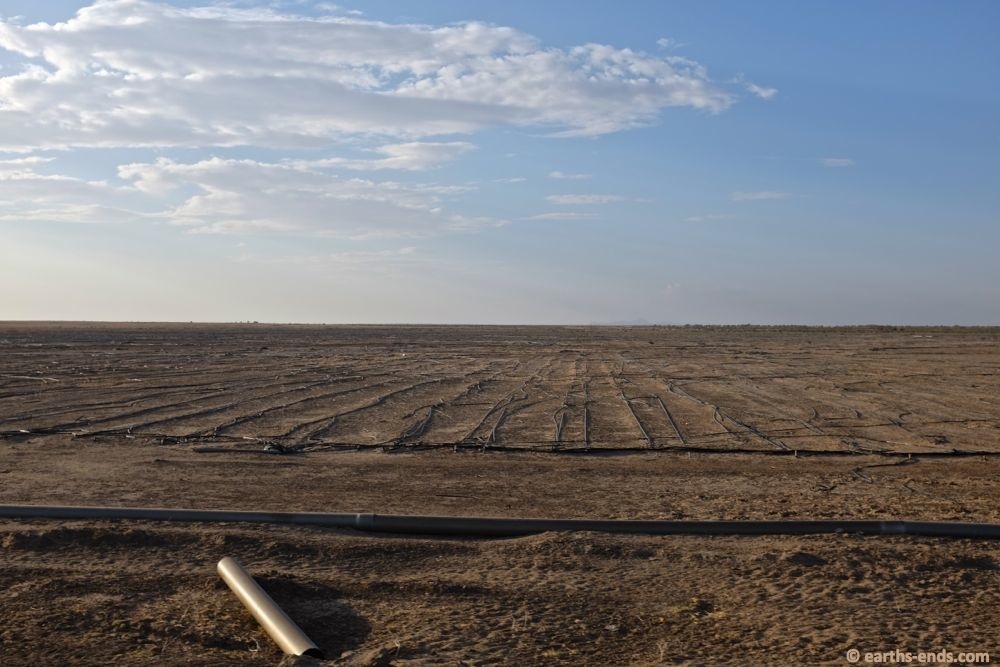
Money + good intentions – realistic planning – follow through = this
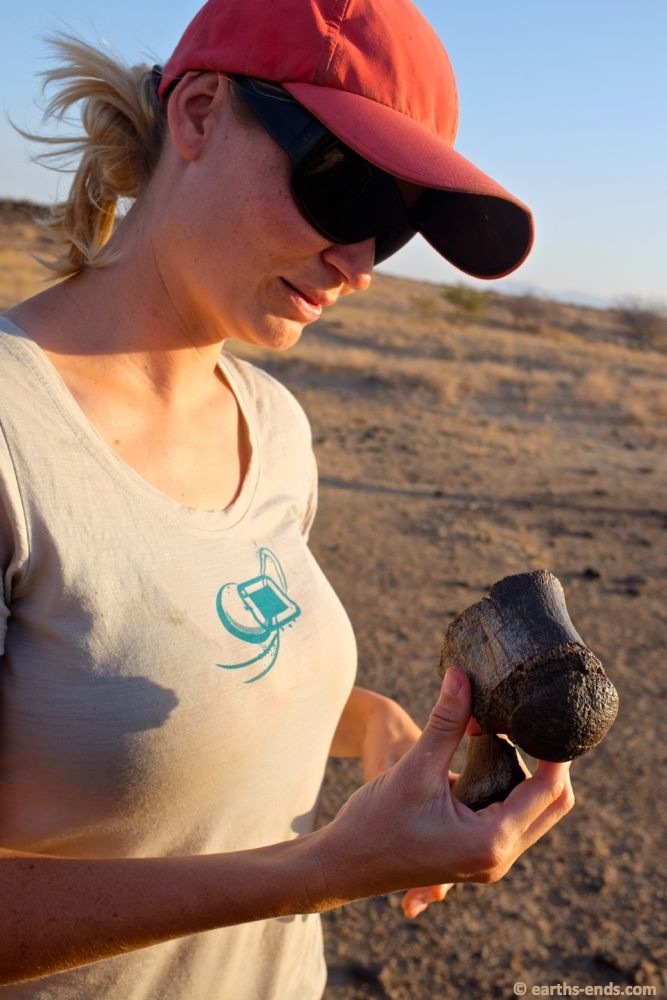
Just near the ridge there is a world class fossil field that has been regularly visited by universities from Europe and the US. Here I am inspecting fossilised fish vertebrae.
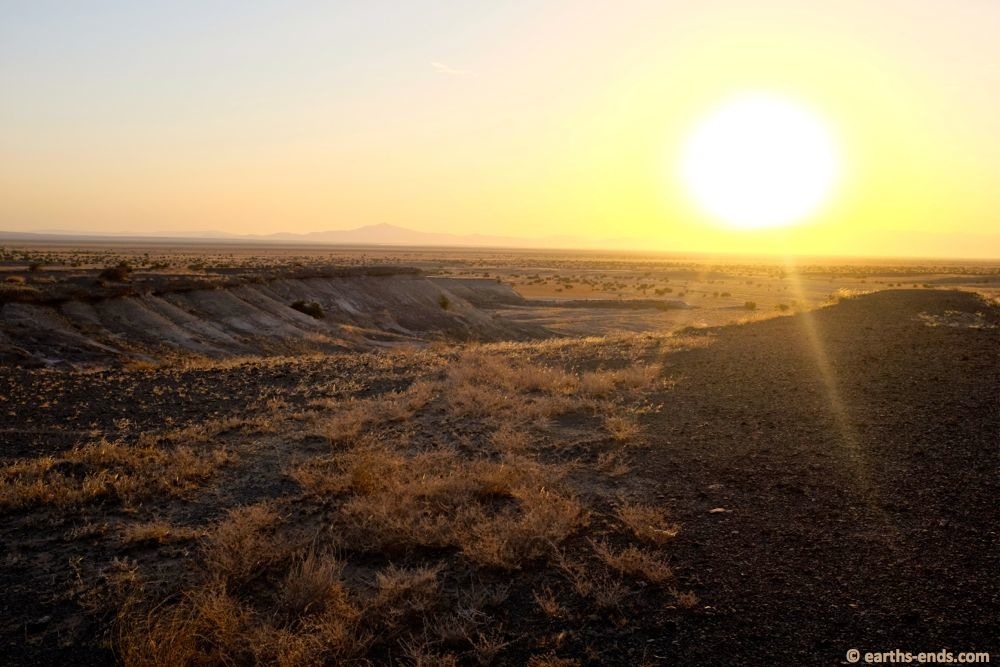
Day’s end.
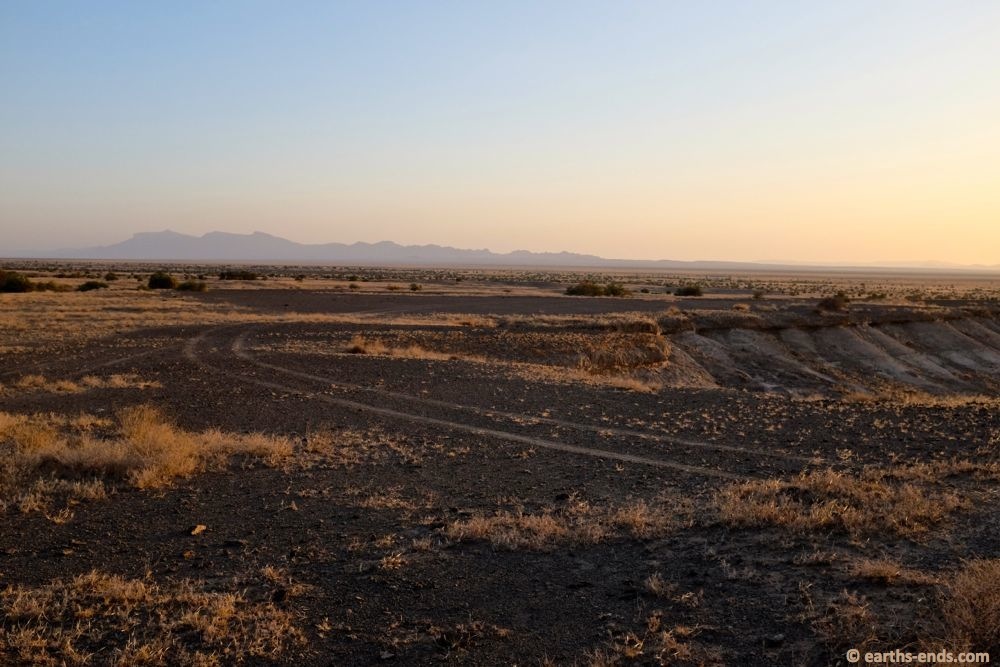
Our kind of beautiful.

The fellas getting the fire started.
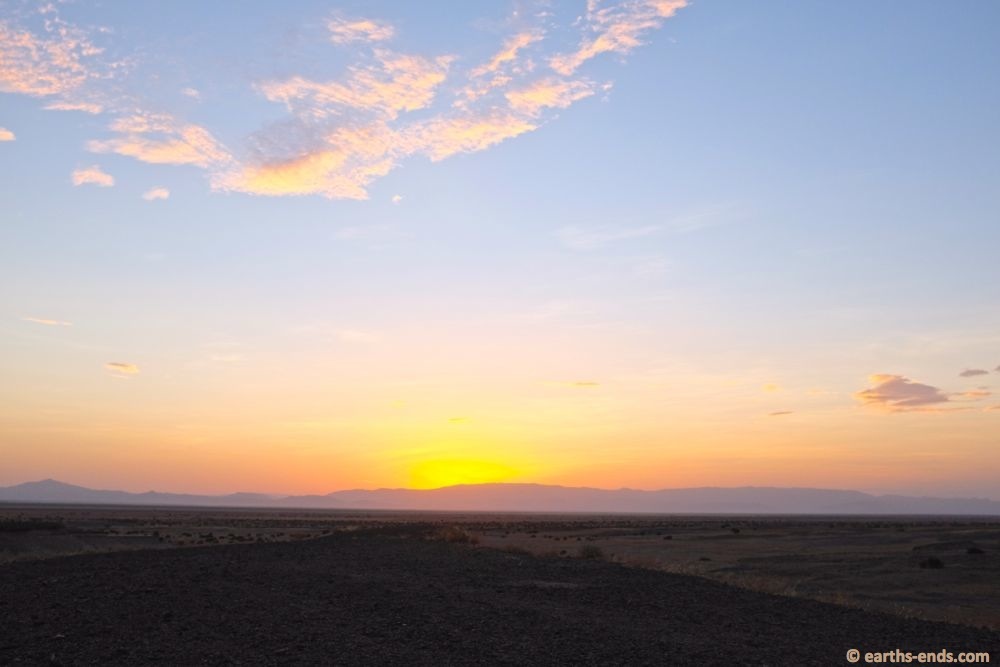
South Sudan in the distance.
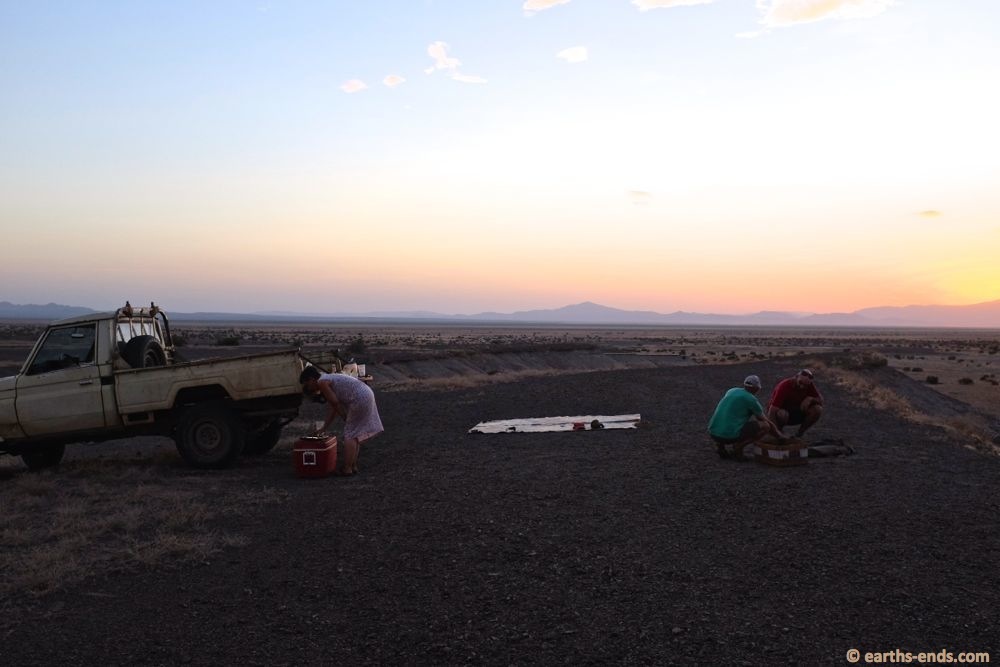
Cook-out.

Toasting weiners
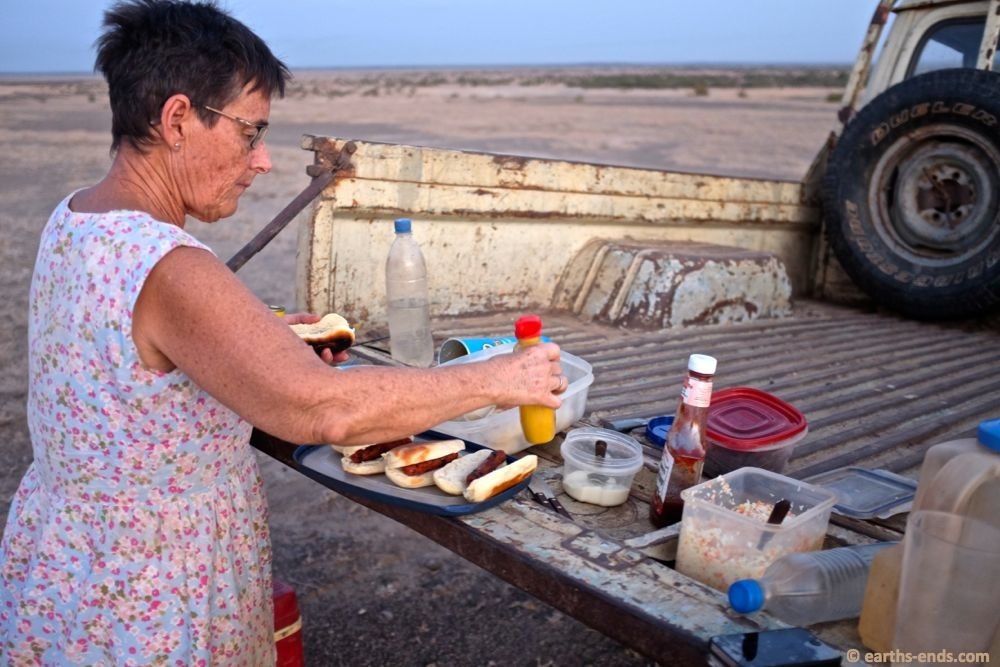
In return for teaching us about the Omo valley we taught Dick and Donna of the beauty and poetry of Australian slang, including such words as ‘maggot bag’, ‘rat coffin’ and ‘budgie smugglers’. Donna proved herself a true Aussie slang proficient by pointing out she was serving us ‘American rat coffins’.
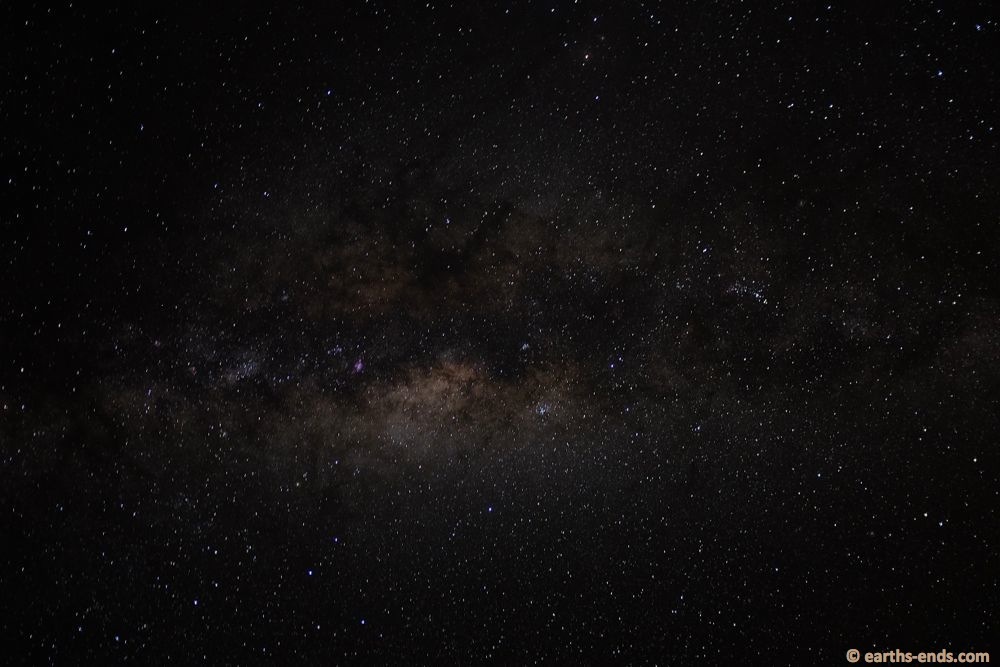
Sometimes you take a photo without knowing what it might mean to someone. Just before leaving the ridge, Mick experimented with our fixed focal length camera. This was the second attempt. When we stopped with Dick’s son Caleb soon after the picture bought tears to his wife Joanna’s eyes. Having recently left Omo she had been missing the Omo stars. We got some prints made for them and left them a copy.
Another day we joined Dick for a visit to the garden of one of the more recent windmill owners. Dick often gets requests for windmill installation but given the amount of work involved in producing and servicing the windmills and the amount of requests he receives, Dick first needs to be convinced that the person has it in them to make the project work on their land. Additionally, Dick needs to avoid a reduction in confidence in the windmills that can result when a windmill is watering a failing garden and worse still, sitting there doing nothing. Dick and Caleb therefore charged a fee for the windmills that is rather hilariously out of sync with the true cost of the mill. However, the fee is crucial to encouraging a sense of ownership and also to sort out who is serious about wanting a windmill and who isn’t. Incidentally the cost of a beautifully made windmill is pegged to the cost of a goat. One goat. About US$25.
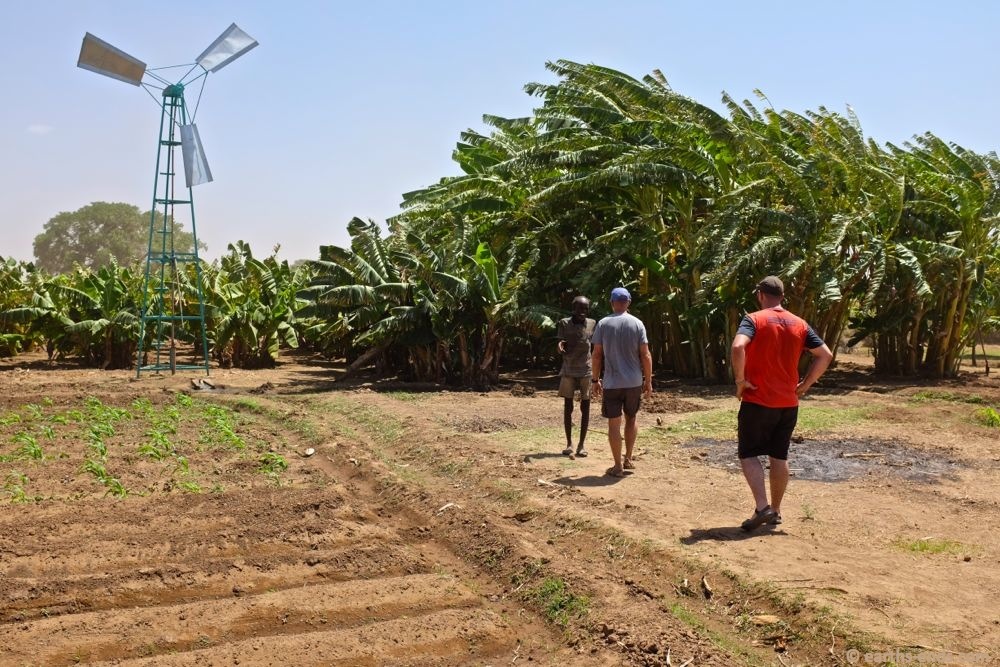
In the garden of one of the more recent windmill recipients.
Dick admitted he was originally quite skeptical about how serious this fellow we were visiting was about getting a windmill. And if, at his extended age, he actually had it in him to do the work necessary to get a mango and banana grove established. At a guess this fellow was 60 to 70 years old, but the Daasenech live hard lives in an extreme environment so we could well be off in this estimate. Yet the man continued to request a windmill and paid the full amount upfront so Dick and Caleb went ahead and installed one on his land.
The old man went on to demonstrate that you can never really know what is inside a person sometimes. He had gone on to create a flourishing garden that has transformed his life. Where he was once a pastoralist that engaged in a bit of seasonal subsistence farming he was now an agriculturalist with a permanent garden, an additional small herd of animals, a more varied and reliable diet, and an income stream. Once his mango trees start fruiting, he can sell mangoes in Omorate for about 25 cents each.
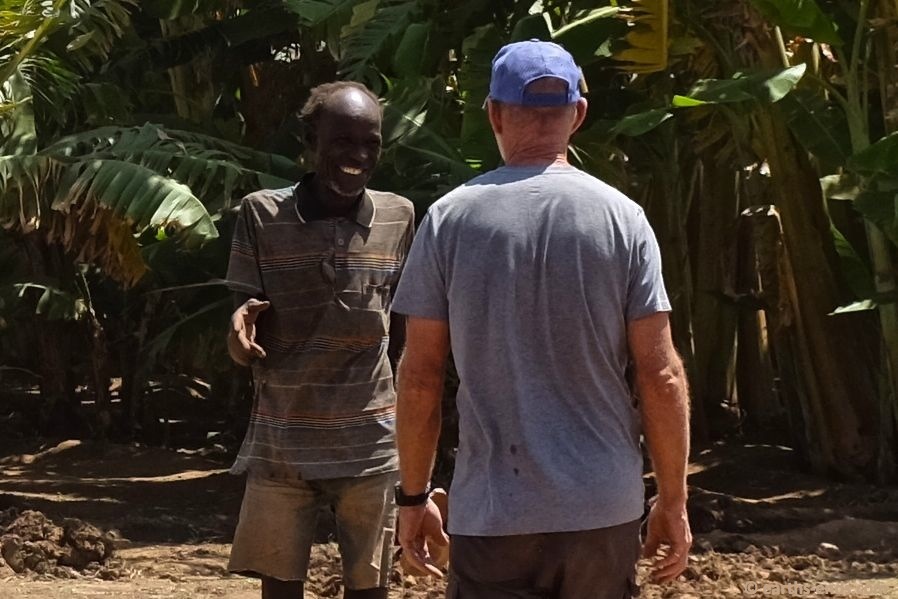
Check out that smile. He seemed so incredibly happy to show Dick his garden. He beamed with pride as he shook Dick’s hand not letting go for a long time.
It was seriously impressive and infinitely clear that the garden was an immense source of pride for him. I don’t think I will ever forget the look on the man’s face as he shook Dick’s hand and showed him the progress of the place since Dick’s last visit about a year ago. The garden was immaculate without a single weed in sight, all the irrigation ditches were clean and well graded, the banana trees were pruned and thorns bushes meticulously placed around mango saplings to protect them until they matured. It reminded me of a Japanese zen garden without a single leaf out of place.
As we toured the garden the fellow and his brother asked Dick if it was really true that the river wasn’t going to flood anymore. The video below shows Dick explaining in the Daasenech language how the dam works and how the dam will halt the flow of the Omo and stop it from flooding. It was pretty sad to witness.

Dick giving some advice.
There had been some level of communication (though hardly consultation) to the local tribes to explain that the river would no longer flood. But those words were incredibly hard for these people to grasp. It was simply too fantastical a concept for the average Daasenech person to comprehend, as they lived simple lives based on the truths that the sun rose in the east, set in the west and the Omo flooded annually. Anyone that had travelled into Omorate would have seen the result of electricity before, yet it is a monumental leap to go from seeing an illuminated light bulb in Omorate to mentally processing a far away dam that holds back the mighty Omo to generate and sell the thing that makes the bulb glow to people on the end of a power line hundreds of kilometers away. It a step further to comprehend that for that to all happen they will have to change their whole way of life. It is not simply a case of lack of education or exposure but a rather human response of having ones experience and imagination far out of step with new realities. Need I point out the current climate change debate in the developed and educated world?
VIDEO TO LOAD SHORTLY
Dick confirmin that the river really won’t be flooding anymore.
Our return to Omo coincided with the conspicuous absence of the annual flood. The non-flooding of the Omo was on everyone’s lips because it was at this time that she should have been spilling over the banks, but as you can see from the photos she was far from doing that.
At this time the Daasenech were struggling to get their heads around the unfathomable, Dick and Donna were trying to provide clarity, all the while the witch doctors were hedging their bets, saying that if it didn’t flood within the next month it would not flood at all.
It is difficult to overstate the effect the damming of Omo is going to have on the lives of the tribal groups of the area. As previously discussed, the Daasenech and other neighbouring tribes seriously love their goats and cows but it is, in a lot of ways, to their own detriment. The number of goats and cows a person has is a direct determinant of their social standing. The greater the number of cows and goats, the greater the man in these parts. As a result the selling and culling animals is avoided at all costs and indeed many cows go on to die of old age. In a land of empty bellies and dietary insufficiencies this is hard for us to grasp.
Harder still was on learning that until relatively recently the Daasenech seldom ate fish despite the Omo teeming with gigantic, good eating fish. The reason for this, you ask? In a land where goats and cattle are king makers, fish are viewed as the food of the poor. It was all a bit much for my foreign mind to process; an empty stomach being less a sign of poverty than a stomach full of Nile Perch.
But Dick and Donna tell us this has changed a lot since they first returned to the Omo. As their family were so keen on fishing and eating the spoils they’d done a lot to change the image of eating fish and have given out many fishing hooks over the years to locals.

Donna with a 95kg (209 pound) Nile perch Dick caught with a single line from out front of their place. They caught this just after we left. Gutted to miss out on a good fish curry.

This fellow asked ‘Diggi’ if he could retrieve his hook and line that had become snagged on a log and he can’t swim. That is the case for many Daasenech.
Back to the livestock, they are causing devastating levels of environmental damage and erosion to the land. Between serious animal over-population and now the curtailing of the annual flood, sporadic conflict between tribes will likely become increasingly frequent as people have to travel farther afield for grazing territory that was becoming all the more limited. This was already underway as we came across a number of family groups on the move as we rode south towards Omorate.
Before arriving in Kangaten, we came across dozens of men, women and children of the Nyangatom tribe carrying their worldly possessions. They looked nervous and unsure which I suppose could have had something to do with the look of us or it could have been due to the knowledge that they were moving closer to the loosely defined margins of their traditional territory. We shook hands in greeting and asked them where Omorate was. They confidently pointed us in a plausible direction. We said out goodbyes and left them to their move.
With the competition for fertile land now on and it appears, as ever, the interests of the cows are superseding that of the people or perhaps I need to make like a Daasenech and view it as one and the same thing. Now the only cropping area is the delta where the lake is receding. It seems this area is going to be a flashpoint for rival tribal conflict as the delta marks the loose tribal boundary and buffer zone between the rival Turkana and Daasenech tribes. All along the Omo, the damming will pit tribe against tribe and in a way man against beast as the only area available to plant will soon become the only areas to graze the many herds of cows in the area. The thing is, it all plays into the hands of the government in a way.

A Nyangatom woman. I wish I could say this was one of our pics but its just one we got from the net to show the general look of the Nyangatom people. It didn’t feel appropriate to whip out the camera while chatting to the Nyangatom people we met on the trail. Their piercing below the lips is typical among men and women.
What is happening in the Omo Valley is essentially grand-scale theft of traditional lands. Tribes at war is a fantastic way for the government to justify their increasing military presence in the area and provides a palatable rationale for modernizing the region. They can claim to be stopping the bloodshed with no need to mention that selling of the lands and water resource to large-scale foreign projects (and those owned by political elites) has effectively forced tribes into conflict. People of the Hamer, or Daasenech or Nyangatom might pull the triggers but the government is loading the guns.

Some of Dick and Donna’s mills.
The Ethiopian government’s attitude to the people groups of the Omo Valley seems far from sympathetic and collaborative. Their traditional way of life is an obstacle to progress in their minds. It appears the average Ethiopian is ashamed of the existence of such primitive tribes when investment, modernisation and economic growth is the order of the day. The young Suri guys we met in Tulegit, Thabu and Baka, do their schooling in Mizan Teferi. They say they are treated as inferior beings as members of one of Omo’s tribal groups. He said they are called black people by fellow Ethiopians. They were amused and dismayed by this as they pointed out “They call us black. They are black people themselves; they don’t even know who they are.”The former Ethiopian Prime Minister Meles Zanawi who championed the dam argued that its construction would bring rapid development to the backward areas of South Omo and minimise conflict in the Omo Valley by allowing water to be released from the dam at times of drought that would otherwise force groups into close quarters in the search of grazing territory. The reports of the government’s brutal tactics of suppressing dissent throws a lot of doubt on to that assertion. At a time of low water levels in the Omo and the dam itself, they maintain they will forgo lucrative electricity generation and obligations to industrial scale farmers and gift the tribes some water. People are seriously expected to believe that? It is exceedingly easy to criticise the Ethiopian government for the project. But is there perhaps not another side to the story that we should explore?
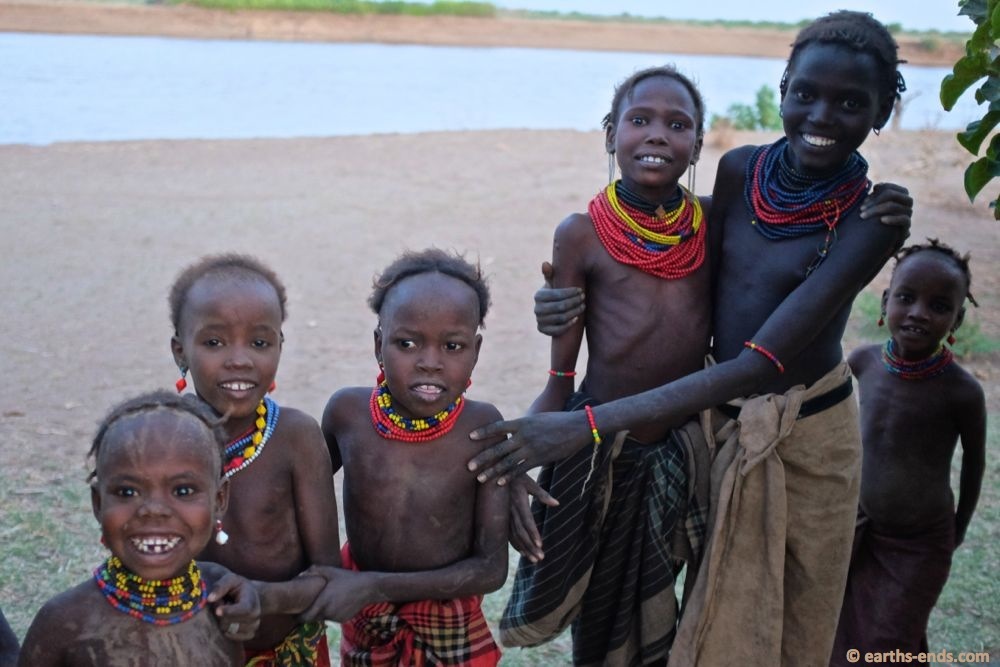
An enthusiastic visit by a group of girls. Much squealing.
Zenawi accused those who opposed the dam (most of them from the ‘West’) of failing to see the advantages of the dam and farming to a country in need of electricity, food security, foreign capital and employment opportunities. He accused people of wanting “the pastoralists and their lifestyle to remain as a tourist attraction forever” and “a case study of ancient living for scientists and researchers.”
As critical of the methods used, the fact I think these farms are bound to fail, and how upset I am for the tribes, I have to acknowledge there may be a kernel of truth to what he is saying. If there wasn’t you wouldn’t have people spending $USD11,000 for 7 day photography tours of the Omo Valley tribes. Yup, that is a real thing.

Here is a general distribution map of the various tribe of the Omo valley. However not all groups are presented here such as the Bodi who have some rather remarkable traditions http://www.dailymail.co.uk/femail/article-2480870/Ethiopian-Bodi-tribe-big-beautiful-men-compete-fattest.html
Outsiders (especially ones from developed countries) often fail to consider how much their world-view is based on how well off and secure their lives are. It is often not a matter of ethics, morals or goodness… but of money. We can prioritise on things other than development, and invest in the preservation of minorities or the environment for example, because we can afford to. The Princess Hwy extension in Australia was delayed for 3 years due for an environmental impact study (based on a rumoured sighting of an endangered species of frog) and then AUD1 million spent on special ponds… for said frogs. Now, we love frogs too and I think investing in our environment is a great thing, but is it fair/realistic to hold developing countries to the same standard?
A generation previous we gave considerably less of a shit about the interests of a minority when there were benefits (especially economic ones) to the majority. When the dam building revolution took place around the world, there were countless people kicked off their traditional lands, their lives irrevocably changed, delicate ecosystems destroyed, whole species of frog wiped out. People in Europe, Australia and the dam builder of note, America, prioritised progress, economic gains and reveled in our ability to build incredible feats of engineering, just like the Ethiopians are doing now. As the Ethiopian governments see it, they are working in the interests of the many over that of the few, which we need to acknowledge, is something our governments have done in the past. They see themselves as trying to climb out of poverty via the ladder used by the developed world. The same ladder the developed world seems to be trying to kick away behind them. The dam will apparently provide a stable electricity supply to 11 million people. How else are they supposed to secure the energy needs for a country of almost 100 million people wanting to industrialise? By using renewable energy exclusively… like Norway? Failing to recognise we have done the same thing before makes criticism of the actions of the Ethiopian government easily dismissible as the sanctimonious ravings of hypocrites. Which, of course, we are.
A realist will acknowledge the deal is effectively done and there is no amount of outside criticism that with see the dam dismantled, business deals undone and lands restored to the tribes. What these tribes need is advocacy from informed people who can assist them in adapting to a new way of life and establishing a new means of self-sufficiency. Relying on government handouts seems the most likely outcome for the people of these tribes but it doesn’t need to be. Things in the Omo Valley might not be as hopeless as they seem.
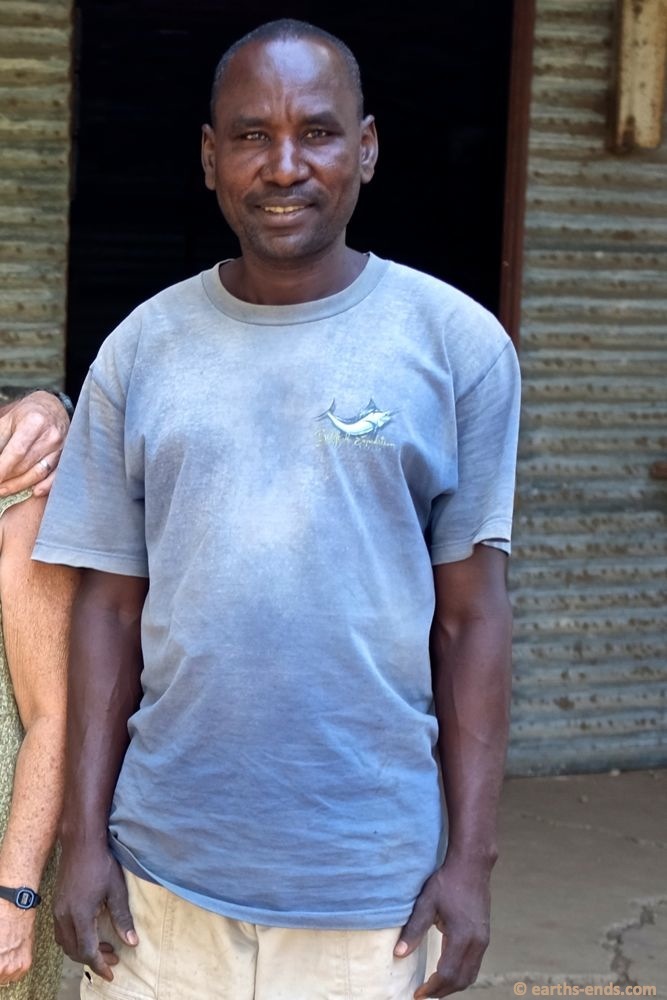
Meet Erogit
Before completely writing off the prospects of our Daasenech friends you should hear the story of Erogit. Erogit is the one of Dick’s workers on the windmill project. Erogit’s father Achew actually worked for Dick’s parents on the mission station before they were given enough time to pack a suitcase each and unceremoniously kicked out of the country in 1978. When Dick later returned to Omo he was immediately recognised by Achew and greeted by name (Diggi). Achew told Dick “we always knew you would return, but what took you so long?” 18 years had past.
Achew was in his 70s when he began working for Dick on the mission once more. At his retirement his son Erogit took over, later to be followed by another son Guradit. These guys assist with the construction and maintenance of the windmills and have a number of sideline business ventures.
Cows are very much a part of Erogit’s life just not in the same way as for most Daasenech. Most Daasenech work to secure as many cattle for themselves as possible. In this regard they can be asset rich but cash poor. Replace cows with houses and you might well see yourself in this same light.
Erogit uses his windmill for growing grass that he uses to fatten up cows he has purchased. Erogit will purchase a skinny but healthy cow for about $300-350, fatten it up for 3 months before selling it for $400-450. Erogit has worked out that by feeding his cows any longer than 3 months, his profits gained become less than the effort and money invested in feeding the cows thereafter. Erogit from the Omo Valley has figured out the law of diminishing returns.
Erogit co-ordinates his cow fattening and selling to fit with major festivals where there is most demand and therefore highest prices for his cows. He had formerly sold directly to restaurant and hotel owners in Omorate. However new government regulations dictate that all cattle deals need to be done in Omorate town, receipts written and taxes paid. Next time you complain that you get nothing for you tax dollars think of the Daasenech.

Riddle me this – One has $10,000 debt, nice belongings and near to no savings. The other has no debt, next to no belongings and a heard of cows worth $30,000. Which one is poor?
Erogit generally has about 2 cows at a time and sells between 6-8 a year. In a good year this might mean he can earn as much as $1200 from his cows alone. In 2014 the GDP per capita for Ethiopia was a mere $315. Erogit from the Omo Valley was almost 4 times better off than the average Ethiopian from keeping just 2 cows at a time. There are significant lessons here for the Daasenech and great cause for hope.
However Erogit, in addition to having a regular job on the windmill projects, also has other income streams such as his solar powered charging station. The brainchild of Dick, it is reliable and tough as guts; a prerequisite for anyone and anything that operates in the Omo Valley. It was designed and built by Dick for nothing but Erogit agreed to pay for the components for a cost of $700. It takes about an hour to charge a phone and can charge 6 phones at a time. It costs about 20 cents per charge and he is generally charging phones all day. It took just one year for his investment to be paid off in full. He has since purchased another.

Mick and Dick talking pumps. I opted out of that conversation.
Erogit has upgraded from a Chinese motorbike to an Indian one, can afford to send his children to a good school and medication for his family at the first sign of illness. He is still a Daasenech and he is an example how, with assistance of people like Dick and Donna, a cultural shift away from a traditional lifestyle that is no longer tenable in its current form, the Daasenech can avoid a fate of hopeless dependency.
I understand the appeal of the tribes of the Omo Valley to foreign outsiders. The jewelry, body painting, hairstyles and head dresses; its evocative an piques the interest. Their very way of life harks back to an ancient time and it seems right to fight against its loss. But it should be remembered that no culture is static, they responds dynamically to new forces.
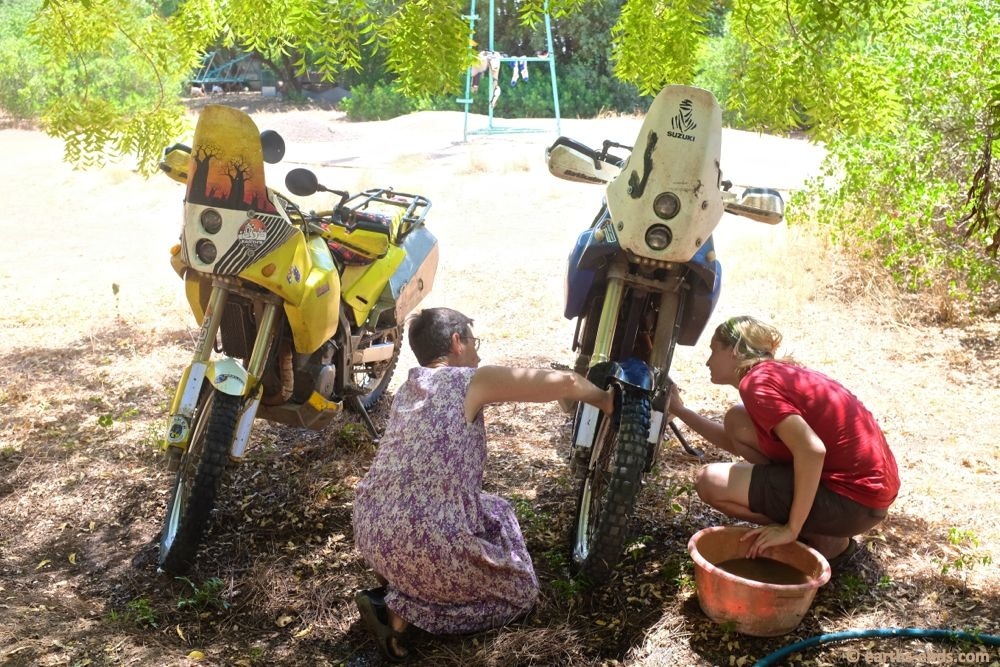
Donna helping me clean the bikes before our departure.
And while the damming of the Omo River has taken a lot of decisions and option out of the hands of the tribes, it still remains within their power to choose what aspects of ‘modern life’ they want to adopt. I feel for the Daasenech and will be rooting for them over the coming year. They have been dealt a tough hand but I don’t like to view it as the end of the Daasenech.
 The boys.
The boys.
About five years ago Daasenech women all wore animal hides. But as cotton alternatives arrived in Omorate and became more affordable they slowly replaced the leather skirts in just about everyone but some old ladies. The women preferred the cotton as they were able to move and work in them more comfortably. They also did away with the large amount of work involved in making the leather skirts. Animals needed to be skinned, leather treated, stretched sewn and worked and worked until their become suitable for wearing. Cotton wraps made life easier and became the new normal. It was change, it was not traditional, yet they choose what worked for them.
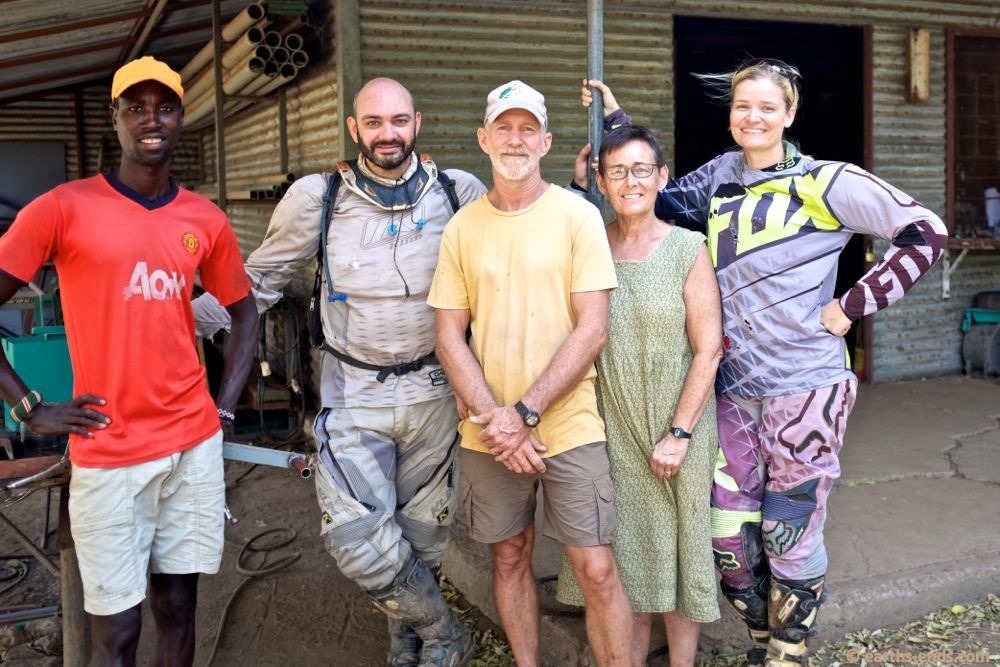
Saying our goodbyes. We would have loved to have stayed longer but we recently decided to tackle the Democratic Republic of Congo crossing so we had a wet season to beat.

Dick and Donna had lost a few chickens of late and Marta and Aster were thrilled to give them a couple of replacements. The new hens were named in our honour. Tan is the light coloured one in the coop. Mick the black one.
You can choose to see change within a culture as a loss (which it is to an extent) but it also represents an opportunity, as politically incorrect as that might sound to foreign ears. The dam has hastened a need for change that already existed. For years the environment has been struggling to support the tribes of the Omo and their herd sizes. My hope would be that the Daasenach could transform their bovine obsession in to one that values smaller herds of larger, stronger and healthier cows. A persons social standing might one day be dictated by how fat their cows are rather than how plentiful. You never know, but it is within their power to decide as much. We needn’t see it as the ruin of a people.
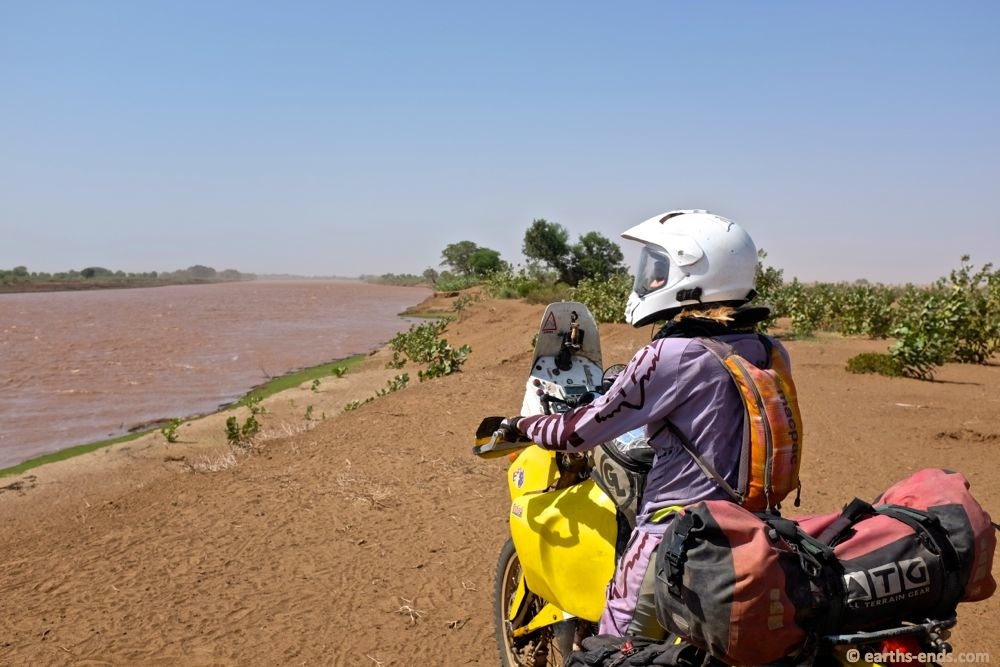
Taking in the last view of the Omo River.
What to say about the Omo? It was a highlight of our time in Ethiopia because it was there that we forged a friendship with perhaps the best people we’ll likely ever meet. Seeing what three generations have done in that part of the world has left Mick and I saying “wow…these guys are so much better at being humans than us.” Dick and Donna are some of the most hard working, devoted and practically minded people we have ever met. They are also almost completely unimpressed by themselves. At one point Donna said that in terms of profoundly influencing the lives of others she estimated that they had affected maybe a dozen or so people. We couldn’t help but think that number was as inadequate a representation of the true number as the $25 price tag for a windmill was to their true value. At the very least they need to add us to that list.

Now to see what the West side of Turkana has to offer.
As this lengthy blog might suggest we loved learning about the area, the tribal groups and the perilous position they find themselves in. Hearing the insider stories of the region though puts us in a weird, almost hypocritical position. We are so glad we visited but can’t help but feel disbelief that the place and its people is billed as one of Ethiopia’s top tourist attractions. Lonely Planet saying ‘its awesome just jump on a bus and go down and have a squizz’ seems insane to us knowing what we know. I’m not trying to paint it as a place where you are targeted or that is particularly dangerous for foreigners. More to us, it just seems like a wild place. And wild things can happen in wild places.
Just a few years ago a communications tower was being constructed near Omorate. One day 3 workers were shot down from it. Dead. No one knows who did it (my money would have been on a fellow suddenly wearing a bunch of girls necklaces) and no one was ever caught. Dick was of the mind that is was probably just a fellow with a gun that wondered if he could hit them all. Turns out he could. So in the context of such happenings, perhaps you’ll understand what I mean when I say naive backpackers might be better off elsewhere. It’s a different story when you are a relatively wary traveller with your own transport. And now with the pressures being what they are in the region, it might be better for excitable backpackers seeking awesome ‘authentic’ experiences to leave these guys to try figure out their place in the world.
 Earths-Ends
Earths-Ends
What a post! I honestly enjoyed reading this! I wish we knew more people at the time to stay with, we would have loved to spend a few more days in that area.
Thanks Michnus! Glad you took the time. Next time you go through East Africa, definitely take the time to do the Omo properly. Its one of the most amazing places on the entire continent. Truly amazing place. But changing so fast!
Man, another great report,Tan’s pics are outstanding,capturing the joy on the kid’s faces..
Thanks Dorion!
Fantastic article! You were indeed lucky to have met Dick and Donna and thus had the opportunity to get to know the people of the Omo Valley better.
Great to hear from you Karin. Yep I totally agree with you. We were so lucky to meet them. I don’t know if you saw the blog of the first time we visited them but that only happened due to a chance meeting with their son Caleb and his family while at a big mall in Nairobi. Caleb had seen out ride report on an adventure bikers forums so recognised my bike. And from that a wonderful friendship was started with him and his family. Lucky indeed.
Tan,
What a great article (merely calling it a blog post just don’t’ do it justice). I honestly thought I just read it out of a magazine with a yellow frame on the cover. There is so much insight and food for thought. I know it requires effort and dedication to research and write it, many times with little or no input from readers. This must be the best “travelers blog” I’ve read.
Just wanted you to know that your work is worth while.
Hi Anders, awesome to hear from you. We have been checking out your blog as well, great stuff. Really enjoyed your post about the DRC->Angola crossing and Sani Pass too. Tanya overheated her rear brake too when she descended (shoosh don’t tell anyone!). Hope you are enjoying East Africa – we really enjoyed Tanzania. Super chilled out vibe and lovely people. Zanzibar is great, the street food scene there is very refreshing after the beans and rice/ugali bore-fest which is Malawi and Tanzania. Absolutely insane homicidal bus drivers though. Mad fuckers! Good luck! Maybe we can catch up again in Europe. We should get to Spain in mid August and then head for South America in November maybe. We plan on doing Ireland, rebuilding the bikes in Amsterdam, visiting friends all through western Europe, and hopefully get to Iran and Oman aswell. So we will be around.
How can you not overheat the rear brake going down the Sanni Pass? I just wonder.
Unfortunately it was Ramadan when I visited Zanzibar so most restaurants were closed during the day and there was no street food at all. Pity. One must take any opportunity to get some good food around here. There was excellent Indian food in Dar Es Salaam though. Tanzanian bus drivers equal those of Nigeria, complete maniacs. I’m considering carrying a big rock to throw in their wind screens when they come roaring against me on my side of the road.
I’m not sure how you will fit Oman and Iran into your route. They are not in Europe, you know. But then again, you guys (guy and gal) are not known to be following logical routes. 🙂 Spain is one of my favorite countries. Don’t miss Segovia. Ronda is great too. There is so much to see in Spain. Iran is also fantastic.
Right now I am pondering how to cross over to Europe, through Egypt and ship the bike, through Sinai and Israel or even Saudi Arabia to Iran and on to Turkey but that is a long, long detour. I want to get to Sweden before the first snow. Maybe our paths will cross in Europe. Let’s keep in touch.
By the way, South America is also one of my favorites, especially the Andes. Way better than Africa if you ask me.
Right now I’m at the Mwanza Yacht Club. Don’t know if you passed by there but it is an overlanders hub. Saw a second 4×4 truck roll in through the gates just now.
Cheers.
Tanya, thanks so much for your thoughtful observations while reporting on your time with Dick and Donna! I thoroughly enjoyed the read!!!
Nate (of your Tanzania blog), who is my son, shared your writing with us.
We were missionaries, living in Nairobi, when Nate was growing up, and spent some time with Dick and Donna when they worked amongst the Orma in eastern Kenya. Nate was about 17 then, and Caleb, maybe eight or so. Nate was astounded when Dick trusted him to take his motorbike out for a spin (and nearly got lost out there in the desert!) All to say, we agree that they are self-less, top-notch folks. I am just delighted at this opportunity to have a peek at their lives again, and see what they are up to and how their people are doing.
We lived in Kenya for about 12 years and more recently spent four years in Sudan, so i really resonate with so much of what you share in your blog. Thanks so much for reporting! It was a bit like a visit home.
Thanks Audrey, we are really glad you enjoyed it. Say hi to Nate for us, we owe him a debt after what he (and Caleb and Joanna too) did for us in Arusha.
One of my favorite entries, Tan! Nice.
Hi Guys,
Reading this old post i stumbled upon the vast internet from my day office off of Manila, Philippines, Asia. I’m in amazement on the life you are living. modern explorers of our current time in a world where everyone is already connected by technology. its nice to see there are still places you can’t just reach through a smartphone screen. I salute your life. its one of my dreams to do the same, explore the world on a off road vehicle with my loveones and do what you guys do. (saying this where I come from a society where you work your arse off to make a living till end). I also have tons of questions regarding your planning before every trip and how you guys sustain the.
for now, I’ll be just reading your site(or youtube?fb page?) for the next adventure!
takecare!